Exploring the Marketing Strategies of Zara
VerifiedAdded on 2019/12/03
|28
|6276
|147
Report
AI Summary
This assignment content includes various articles and documents related to marketing. It discusses the intersection of marketing science and engineering, ethical issues in guerilla marketing, and social issues in global marketing. Additionally, it touches on organizational commitment, active learning of ethical issues, and producing marketing work. The content also explores different frameworks such as BCG Matrix, PESTLE Analysis, and Porter's Five Forces Model. Furthermore, it highlights the importance of understanding top companies' SWOT analysis information and their strategies for success.
Contribute Materials
Your contribution can guide someone’s learning journey. Share your
documents today.

Marketing Planning
Secure Best Marks with AI Grader
Need help grading? Try our AI Grader for instant feedback on your assignments.
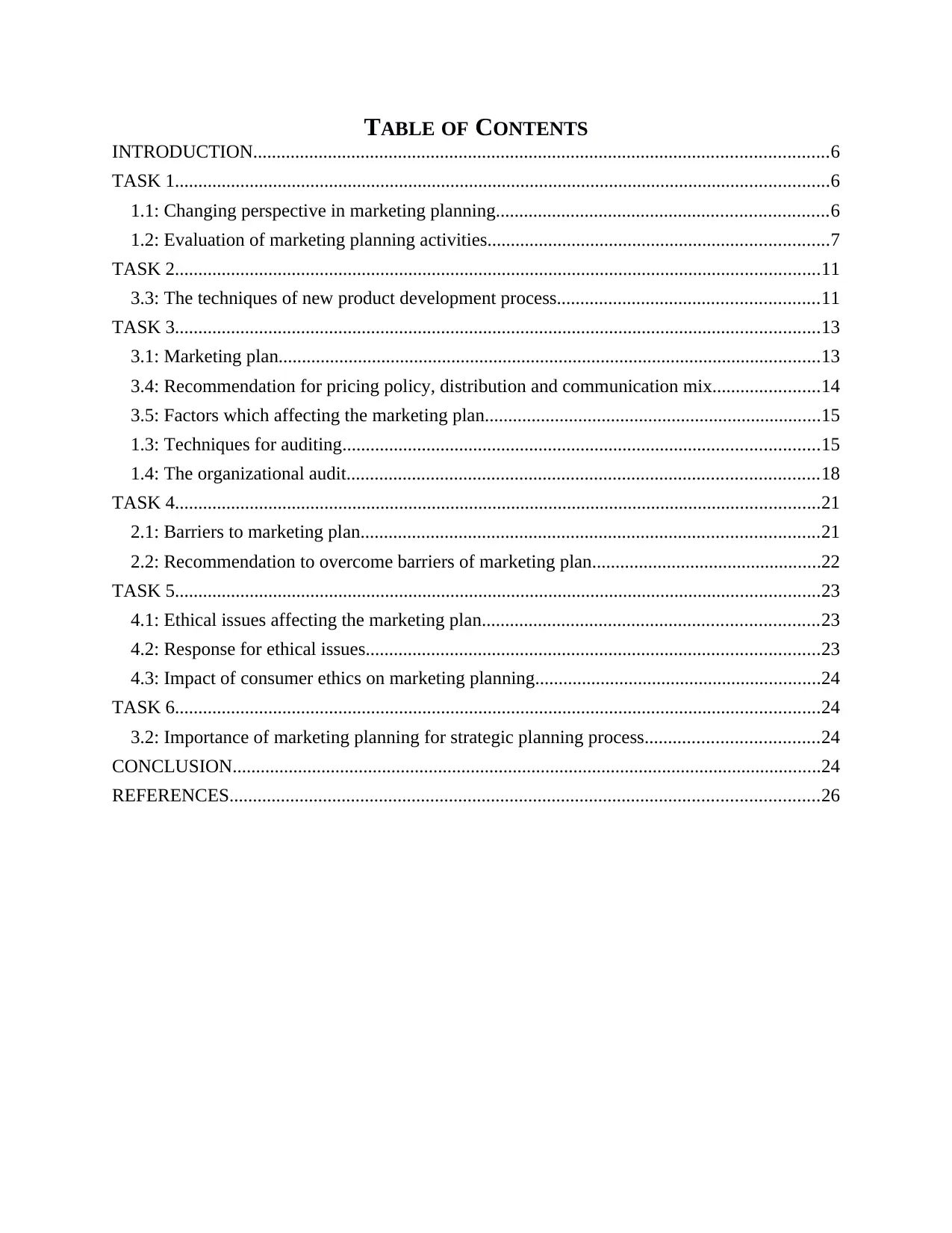
TABLE OF CONTENTS
INTRODUCTION...........................................................................................................................6
TASK 1............................................................................................................................................6
1.1: Changing perspective in marketing planning.......................................................................6
1.2: Evaluation of marketing planning activities.........................................................................7
TASK 2..........................................................................................................................................11
3.3: The techniques of new product development process........................................................11
TASK 3..........................................................................................................................................13
3.1: Marketing plan....................................................................................................................13
3.4: Recommendation for pricing policy, distribution and communication mix.......................14
3.5: Factors which affecting the marketing plan........................................................................15
1.3: Techniques for auditing......................................................................................................15
1.4: The organizational audit.....................................................................................................18
TASK 4..........................................................................................................................................21
2.1: Barriers to marketing plan..................................................................................................21
2.2: Recommendation to overcome barriers of marketing plan.................................................22
TASK 5..........................................................................................................................................23
4.1: Ethical issues affecting the marketing plan........................................................................23
4.2: Response for ethical issues.................................................................................................23
4.3: Impact of consumer ethics on marketing planning.............................................................24
TASK 6..........................................................................................................................................24
3.2: Importance of marketing planning for strategic planning process.....................................24
CONCLUSION..............................................................................................................................24
REFERENCES..............................................................................................................................26
INTRODUCTION...........................................................................................................................6
TASK 1............................................................................................................................................6
1.1: Changing perspective in marketing planning.......................................................................6
1.2: Evaluation of marketing planning activities.........................................................................7
TASK 2..........................................................................................................................................11
3.3: The techniques of new product development process........................................................11
TASK 3..........................................................................................................................................13
3.1: Marketing plan....................................................................................................................13
3.4: Recommendation for pricing policy, distribution and communication mix.......................14
3.5: Factors which affecting the marketing plan........................................................................15
1.3: Techniques for auditing......................................................................................................15
1.4: The organizational audit.....................................................................................................18
TASK 4..........................................................................................................................................21
2.1: Barriers to marketing plan..................................................................................................21
2.2: Recommendation to overcome barriers of marketing plan.................................................22
TASK 5..........................................................................................................................................23
4.1: Ethical issues affecting the marketing plan........................................................................23
4.2: Response for ethical issues.................................................................................................23
4.3: Impact of consumer ethics on marketing planning.............................................................24
TASK 6..........................................................................................................................................24
3.2: Importance of marketing planning for strategic planning process.....................................24
CONCLUSION..............................................................................................................................24
REFERENCES..............................................................................................................................26
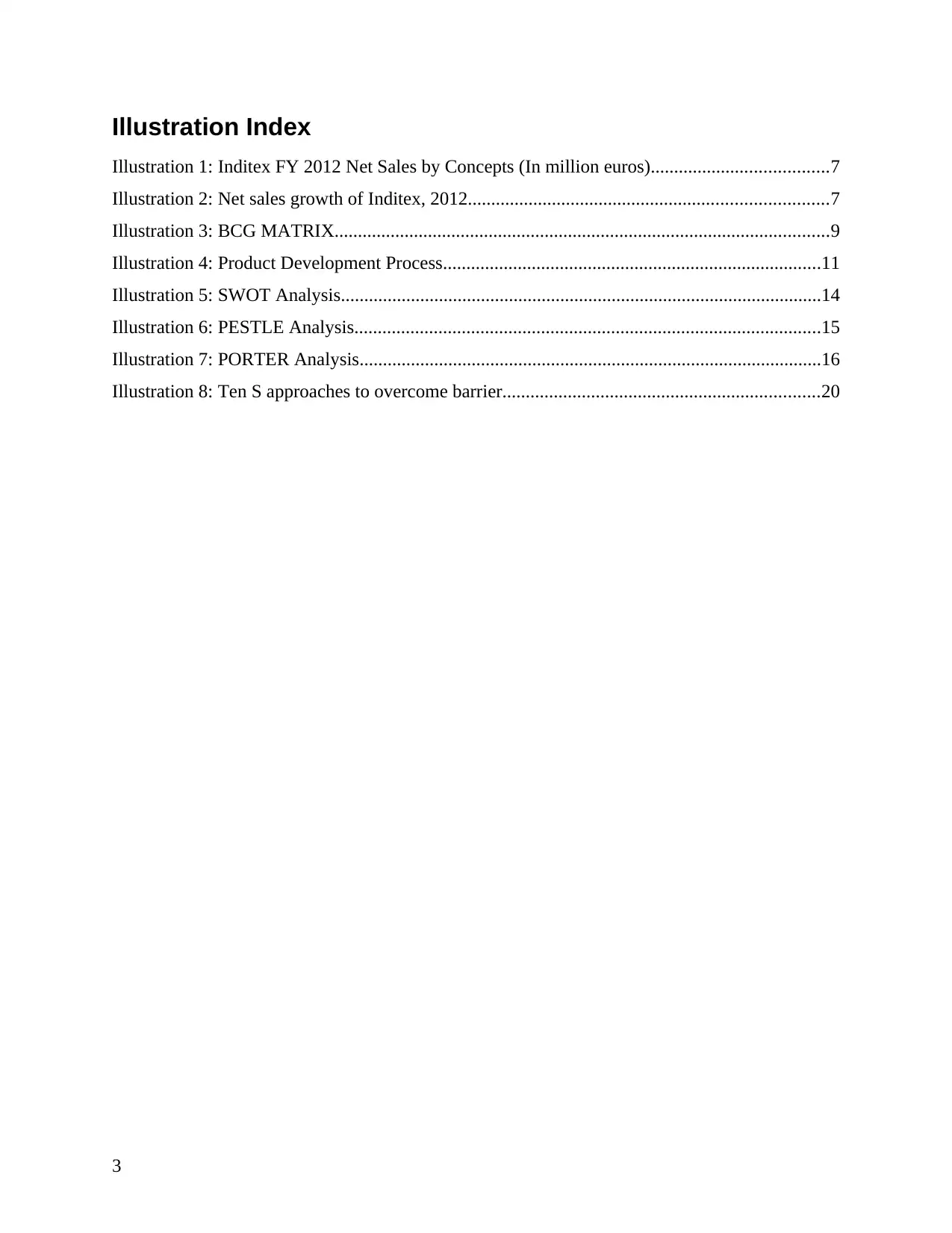
Illustration Index
Illustration 1: Inditex FY 2012 Net Sales by Concepts (In million euros)......................................7
Illustration 2: Net sales growth of Inditex, 2012.............................................................................7
Illustration 3: BCG MATRIX..........................................................................................................9
Illustration 4: Product Development Process.................................................................................11
Illustration 5: SWOT Analysis.......................................................................................................14
Illustration 6: PESTLE Analysis....................................................................................................15
Illustration 7: PORTER Analysis...................................................................................................16
Illustration 8: Ten S approaches to overcome barrier....................................................................20
3
Illustration 1: Inditex FY 2012 Net Sales by Concepts (In million euros)......................................7
Illustration 2: Net sales growth of Inditex, 2012.............................................................................7
Illustration 3: BCG MATRIX..........................................................................................................9
Illustration 4: Product Development Process.................................................................................11
Illustration 5: SWOT Analysis.......................................................................................................14
Illustration 6: PESTLE Analysis....................................................................................................15
Illustration 7: PORTER Analysis...................................................................................................16
Illustration 8: Ten S approaches to overcome barrier....................................................................20
3
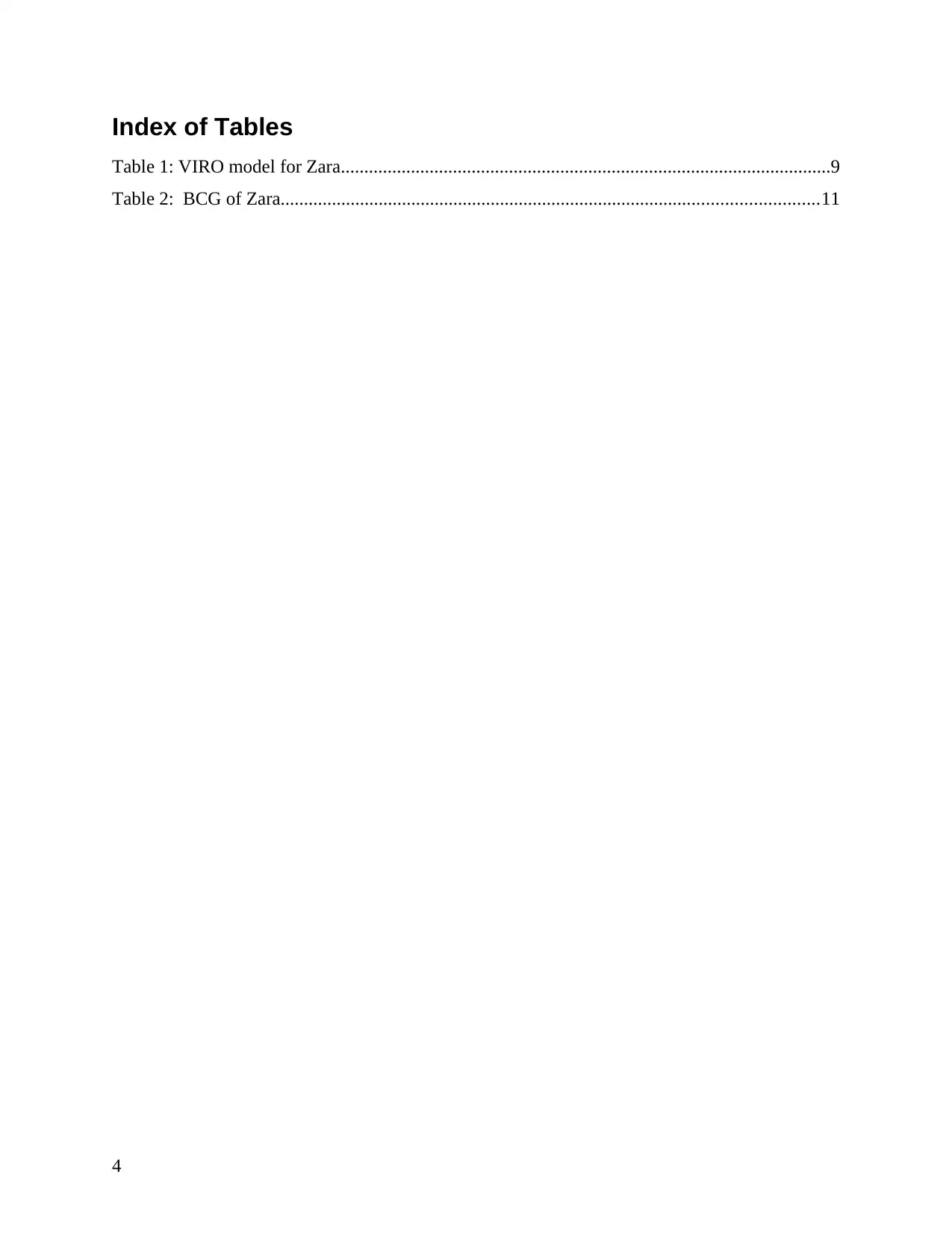
Index of Tables
Table 1: VIRO model for Zara.........................................................................................................9
Table 2: BCG of Zara...................................................................................................................11
4
Table 1: VIRO model for Zara.........................................................................................................9
Table 2: BCG of Zara...................................................................................................................11
4
Secure Best Marks with AI Grader
Need help grading? Try our AI Grader for instant feedback on your assignments.
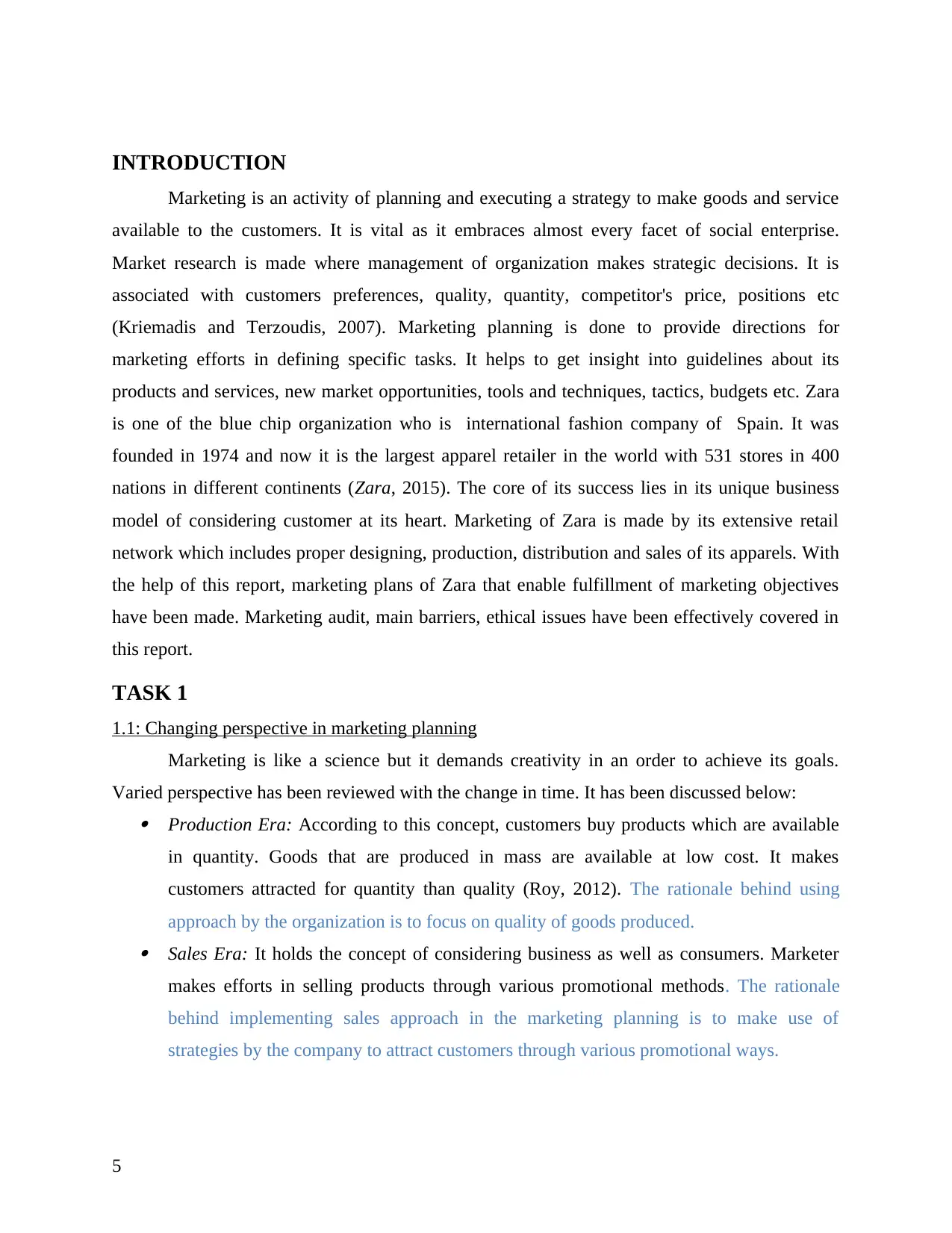
INTRODUCTION
Marketing is an activity of planning and executing a strategy to make goods and service
available to the customers. It is vital as it embraces almost every facet of social enterprise.
Market research is made where management of organization makes strategic decisions. It is
associated with customers preferences, quality, quantity, competitor's price, positions etc
(Kriemadis and Terzoudis, 2007). Marketing planning is done to provide directions for
marketing efforts in defining specific tasks. It helps to get insight into guidelines about its
products and services, new market opportunities, tools and techniques, tactics, budgets etc. Zara
is one of the blue chip organization who is international fashion company of Spain. It was
founded in 1974 and now it is the largest apparel retailer in the world with 531 stores in 400
nations in different continents (Zara, 2015). The core of its success lies in its unique business
model of considering customer at its heart. Marketing of Zara is made by its extensive retail
network which includes proper designing, production, distribution and sales of its apparels. With
the help of this report, marketing plans of Zara that enable fulfillment of marketing objectives
have been made. Marketing audit, main barriers, ethical issues have been effectively covered in
this report.
TASK 1
1.1: Changing perspective in marketing planning
Marketing is like a science but it demands creativity in an order to achieve its goals.
Varied perspective has been reviewed with the change in time. It has been discussed below: Production Era: According to this concept, customers buy products which are available
in quantity. Goods that are produced in mass are available at low cost. It makes
customers attracted for quantity than quality (Roy, 2012). The rationale behind using
approach by the organization is to focus on quality of goods produced. Sales Era: It holds the concept of considering business as well as consumers. Marketer
makes efforts in selling products through various promotional methods. The rationale
behind implementing sales approach in the marketing planning is to make use of
strategies by the company to attract customers through various promotional ways.
5
Marketing is an activity of planning and executing a strategy to make goods and service
available to the customers. It is vital as it embraces almost every facet of social enterprise.
Market research is made where management of organization makes strategic decisions. It is
associated with customers preferences, quality, quantity, competitor's price, positions etc
(Kriemadis and Terzoudis, 2007). Marketing planning is done to provide directions for
marketing efforts in defining specific tasks. It helps to get insight into guidelines about its
products and services, new market opportunities, tools and techniques, tactics, budgets etc. Zara
is one of the blue chip organization who is international fashion company of Spain. It was
founded in 1974 and now it is the largest apparel retailer in the world with 531 stores in 400
nations in different continents (Zara, 2015). The core of its success lies in its unique business
model of considering customer at its heart. Marketing of Zara is made by its extensive retail
network which includes proper designing, production, distribution and sales of its apparels. With
the help of this report, marketing plans of Zara that enable fulfillment of marketing objectives
have been made. Marketing audit, main barriers, ethical issues have been effectively covered in
this report.
TASK 1
1.1: Changing perspective in marketing planning
Marketing is like a science but it demands creativity in an order to achieve its goals.
Varied perspective has been reviewed with the change in time. It has been discussed below: Production Era: According to this concept, customers buy products which are available
in quantity. Goods that are produced in mass are available at low cost. It makes
customers attracted for quantity than quality (Roy, 2012). The rationale behind using
approach by the organization is to focus on quality of goods produced. Sales Era: It holds the concept of considering business as well as consumers. Marketer
makes efforts in selling products through various promotional methods. The rationale
behind implementing sales approach in the marketing planning is to make use of
strategies by the company to attract customers through various promotional ways.
5
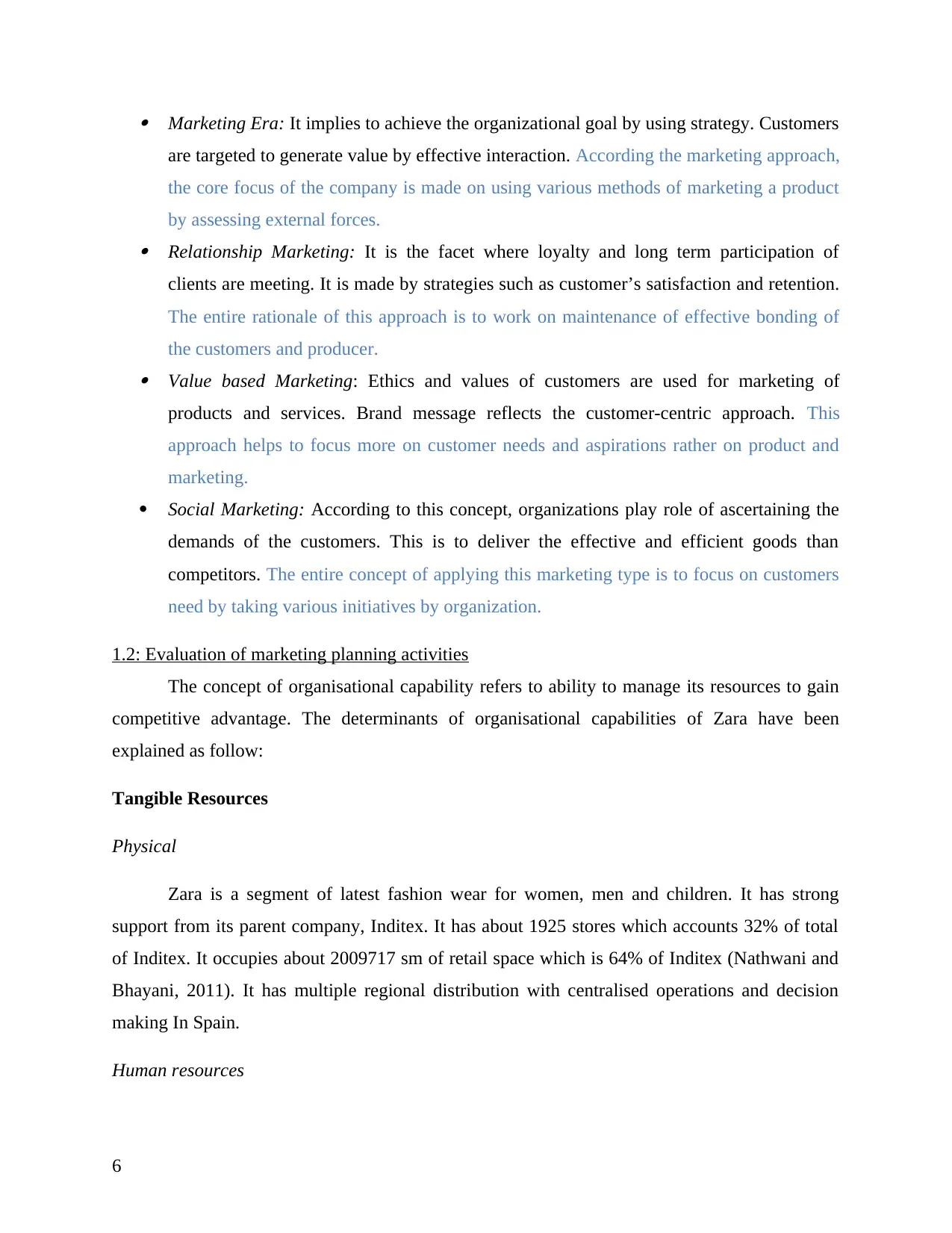
Marketing Era: It implies to achieve the organizational goal by using strategy. Customers
are targeted to generate value by effective interaction. According the marketing approach,
the core focus of the company is made on using various methods of marketing a product
by assessing external forces. Relationship Marketing: It is the facet where loyalty and long term participation of
clients are meeting. It is made by strategies such as customer’s satisfaction and retention.
The entire rationale of this approach is to work on maintenance of effective bonding of
the customers and producer. Value based Marketing: Ethics and values of customers are used for marketing of
products and services. Brand message reflects the customer-centric approach. This
approach helps to focus more on customer needs and aspirations rather on product and
marketing.
Social Marketing: According to this concept, organizations play role of ascertaining the
demands of the customers. This is to deliver the effective and efficient goods than
competitors. The entire concept of applying this marketing type is to focus on customers
need by taking various initiatives by organization.
1.2: Evaluation of marketing planning activities
The concept of organisational capability refers to ability to manage its resources to gain
competitive advantage. The determinants of organisational capabilities of Zara have been
explained as follow:
Tangible Resources
Physical
Zara is a segment of latest fashion wear for women, men and children. It has strong
support from its parent company, Inditex. It has about 1925 stores which accounts 32% of total
of Inditex. It occupies about 2009717 sm of retail space which is 64% of Inditex (Nathwani and
Bhayani, 2011). It has multiple regional distribution with centralised operations and decision
making In Spain.
Human resources
6
are targeted to generate value by effective interaction. According the marketing approach,
the core focus of the company is made on using various methods of marketing a product
by assessing external forces. Relationship Marketing: It is the facet where loyalty and long term participation of
clients are meeting. It is made by strategies such as customer’s satisfaction and retention.
The entire rationale of this approach is to work on maintenance of effective bonding of
the customers and producer. Value based Marketing: Ethics and values of customers are used for marketing of
products and services. Brand message reflects the customer-centric approach. This
approach helps to focus more on customer needs and aspirations rather on product and
marketing.
Social Marketing: According to this concept, organizations play role of ascertaining the
demands of the customers. This is to deliver the effective and efficient goods than
competitors. The entire concept of applying this marketing type is to focus on customers
need by taking various initiatives by organization.
1.2: Evaluation of marketing planning activities
The concept of organisational capability refers to ability to manage its resources to gain
competitive advantage. The determinants of organisational capabilities of Zara have been
explained as follow:
Tangible Resources
Physical
Zara is a segment of latest fashion wear for women, men and children. It has strong
support from its parent company, Inditex. It has about 1925 stores which accounts 32% of total
of Inditex. It occupies about 2009717 sm of retail space which is 64% of Inditex (Nathwani and
Bhayani, 2011). It has multiple regional distribution with centralised operations and decision
making In Spain.
Human resources
6
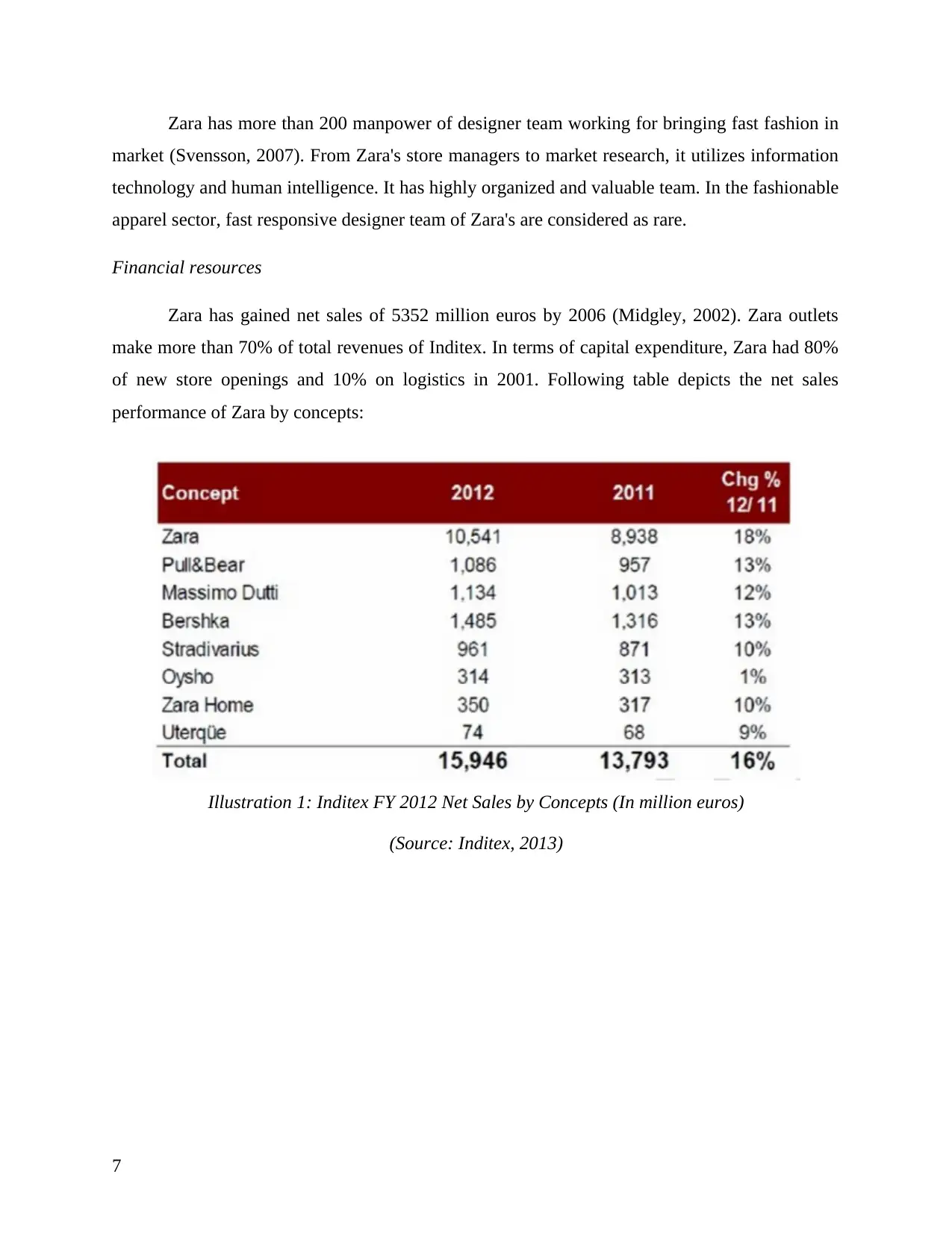
Zara has more than 200 manpower of designer team working for bringing fast fashion in
market (Svensson, 2007). From Zara's store managers to market research, it utilizes information
technology and human intelligence. It has highly organized and valuable team. In the fashionable
apparel sector, fast responsive designer team of Zara's are considered as rare.
Financial resources
Zara has gained net sales of 5352 million euros by 2006 (Midgley, 2002). Zara outlets
make more than 70% of total revenues of Inditex. In terms of capital expenditure, Zara had 80%
of new store openings and 10% on logistics in 2001. Following table depicts the net sales
performance of Zara by concepts:
7
Illustration 1: Inditex FY 2012 Net Sales by Concepts (In million euros)
(Source: Inditex, 2013)
market (Svensson, 2007). From Zara's store managers to market research, it utilizes information
technology and human intelligence. It has highly organized and valuable team. In the fashionable
apparel sector, fast responsive designer team of Zara's are considered as rare.
Financial resources
Zara has gained net sales of 5352 million euros by 2006 (Midgley, 2002). Zara outlets
make more than 70% of total revenues of Inditex. In terms of capital expenditure, Zara had 80%
of new store openings and 10% on logistics in 2001. Following table depicts the net sales
performance of Zara by concepts:
7
Illustration 1: Inditex FY 2012 Net Sales by Concepts (In million euros)
(Source: Inditex, 2013)
Paraphrase This Document
Need a fresh take? Get an instant paraphrase of this document with our AI Paraphraser
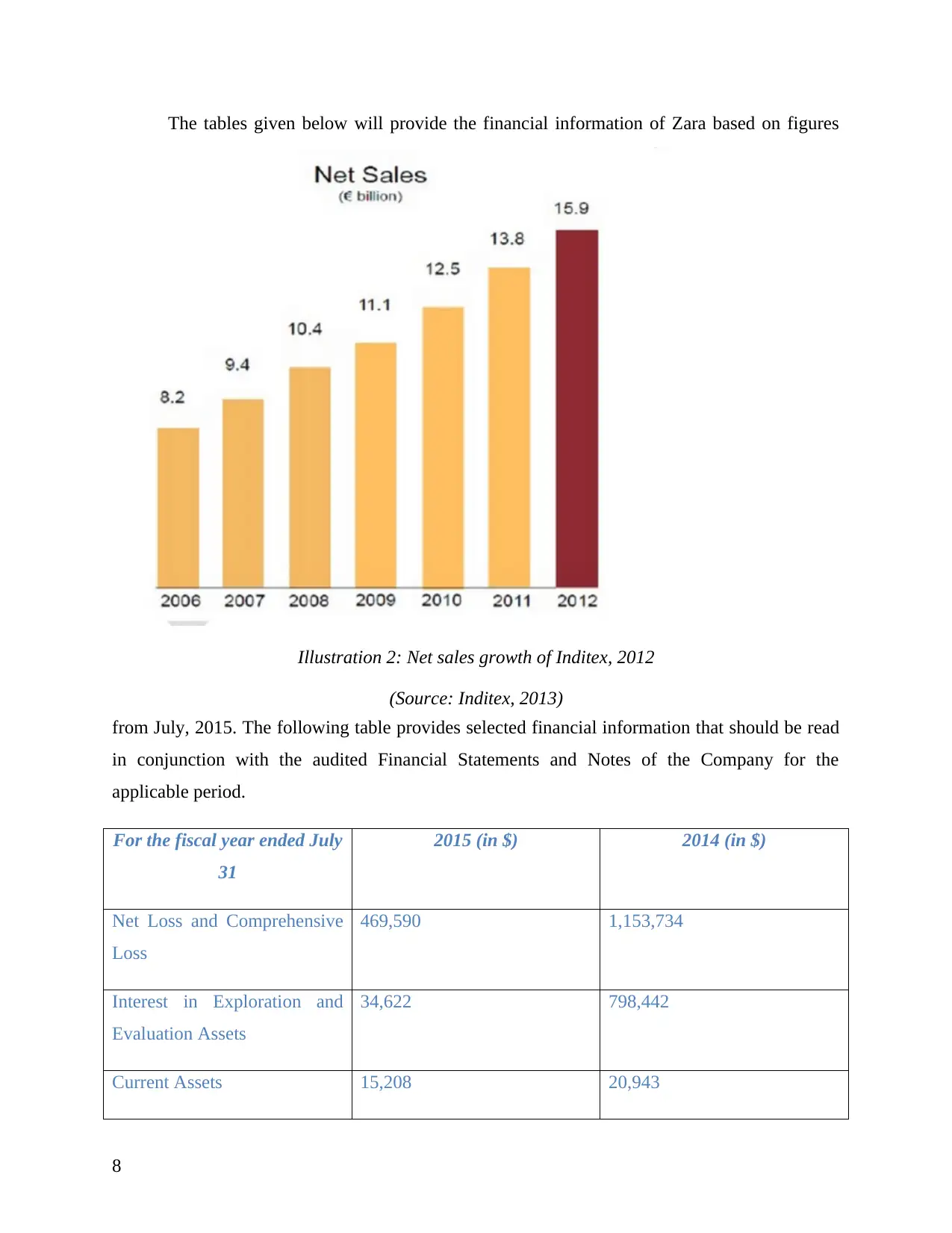
The tables given below will provide the financial information of Zara based on figures
from July, 2015. The following table provides selected financial information that should be read
in conjunction with the audited Financial Statements and Notes of the Company for the
applicable period.
For the fiscal year ended July
31
2015 (in $) 2014 (in $)
Net Loss and Comprehensive
Loss
469,590 1,153,734
Interest in Exploration and
Evaluation Assets
34,622 798,442
Current Assets 15,208 20,943
8
Illustration 2: Net sales growth of Inditex, 2012
(Source: Inditex, 2013)
from July, 2015. The following table provides selected financial information that should be read
in conjunction with the audited Financial Statements and Notes of the Company for the
applicable period.
For the fiscal year ended July
31
2015 (in $) 2014 (in $)
Net Loss and Comprehensive
Loss
469,590 1,153,734
Interest in Exploration and
Evaluation Assets
34,622 798,442
Current Assets 15,208 20,943
8
Illustration 2: Net sales growth of Inditex, 2012
(Source: Inditex, 2013)
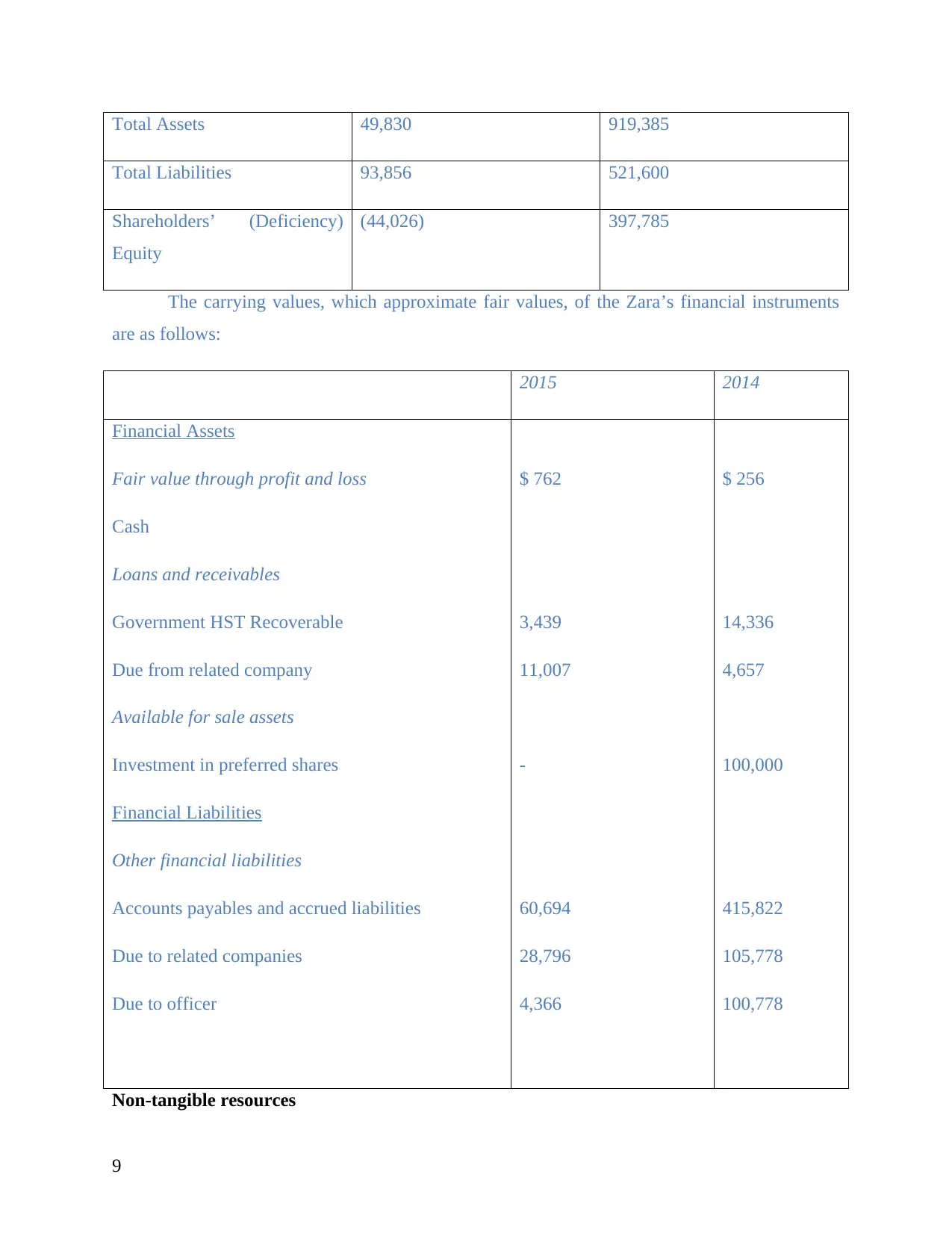
Total Assets 49,830 919,385
Total Liabilities 93,856 521,600
Shareholders’ (Deficiency)
Equity
(44,026) 397,785
The carrying values, which approximate fair values, of the Zara’s financial instruments
are as follows:
2015 2014
Financial Assets
Fair value through profit and loss
Cash
Loans and receivables
Government HST Recoverable
Due from related company
Available for sale assets
Investment in preferred shares
Financial Liabilities
Other financial liabilities
Accounts payables and accrued liabilities
Due to related companies
Due to officer
$ 762
3,439
11,007
-
60,694
28,796
4,366
$ 256
14,336
4,657
100,000
415,822
105,778
100,778
Non-tangible resources
9
Total Liabilities 93,856 521,600
Shareholders’ (Deficiency)
Equity
(44,026) 397,785
The carrying values, which approximate fair values, of the Zara’s financial instruments
are as follows:
2015 2014
Financial Assets
Fair value through profit and loss
Cash
Loans and receivables
Government HST Recoverable
Due from related company
Available for sale assets
Investment in preferred shares
Financial Liabilities
Other financial liabilities
Accounts payables and accrued liabilities
Due to related companies
Due to officer
$ 762
3,439
11,007
-
60,694
28,796
4,366
$ 256
14,336
4,657
100,000
415,822
105,778
100,778
Non-tangible resources
9
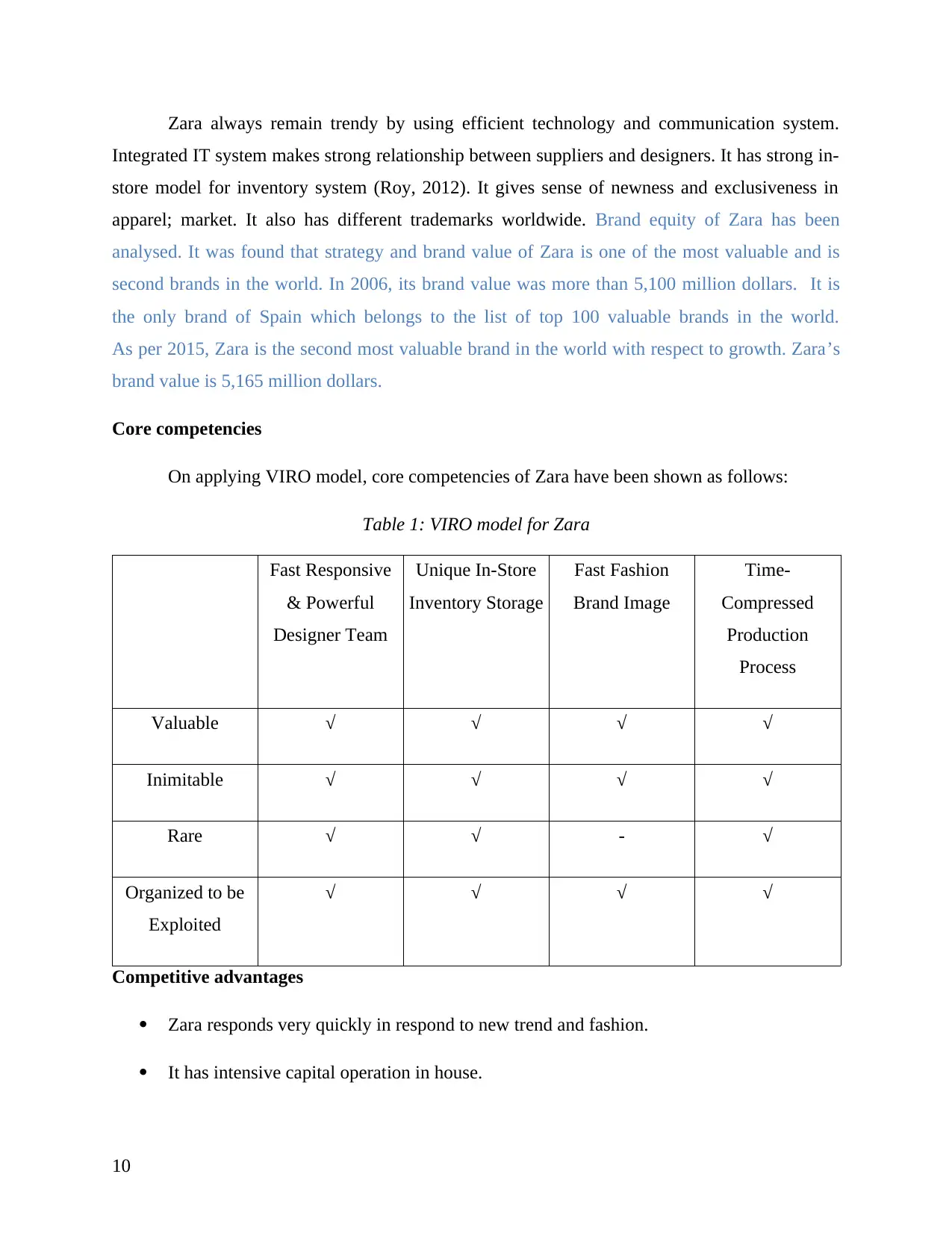
Zara always remain trendy by using efficient technology and communication system.
Integrated IT system makes strong relationship between suppliers and designers. It has strong in-
store model for inventory system (Roy, 2012). It gives sense of newness and exclusiveness in
apparel; market. It also has different trademarks worldwide. Brand equity of Zara has been
analysed. It was found that strategy and brand value of Zara is one of the most valuable and is
second brands in the world. In 2006, its brand value was more than 5,100 million dollars. It is
the only brand of Spain which belongs to the list of top 100 valuable brands in the world.
As per 2015, Zara is the second most valuable brand in the world with respect to growth. Zara’s
brand value is 5,165 million dollars.
Core competencies
On applying VIRO model, core competencies of Zara have been shown as follows:
Table 1: VIRO model for Zara
Fast Responsive
& Powerful
Designer Team
Unique In-Store
Inventory Storage
Fast Fashion
Brand Image
Time-
Compressed
Production
Process
Valuable √ √ √ √
Inimitable √ √ √ √
Rare √ √ - √
Organized to be
Exploited
√ √ √ √
Competitive advantages
Zara responds very quickly in respond to new trend and fashion.
It has intensive capital operation in house.
10
Integrated IT system makes strong relationship between suppliers and designers. It has strong in-
store model for inventory system (Roy, 2012). It gives sense of newness and exclusiveness in
apparel; market. It also has different trademarks worldwide. Brand equity of Zara has been
analysed. It was found that strategy and brand value of Zara is one of the most valuable and is
second brands in the world. In 2006, its brand value was more than 5,100 million dollars. It is
the only brand of Spain which belongs to the list of top 100 valuable brands in the world.
As per 2015, Zara is the second most valuable brand in the world with respect to growth. Zara’s
brand value is 5,165 million dollars.
Core competencies
On applying VIRO model, core competencies of Zara have been shown as follows:
Table 1: VIRO model for Zara
Fast Responsive
& Powerful
Designer Team
Unique In-Store
Inventory Storage
Fast Fashion
Brand Image
Time-
Compressed
Production
Process
Valuable √ √ √ √
Inimitable √ √ √ √
Rare √ √ - √
Organized to be
Exploited
√ √ √ √
Competitive advantages
Zara responds very quickly in respond to new trend and fashion.
It has intensive capital operation in house.
10
Secure Best Marks with AI Grader
Need help grading? Try our AI Grader for instant feedback on your assignments.
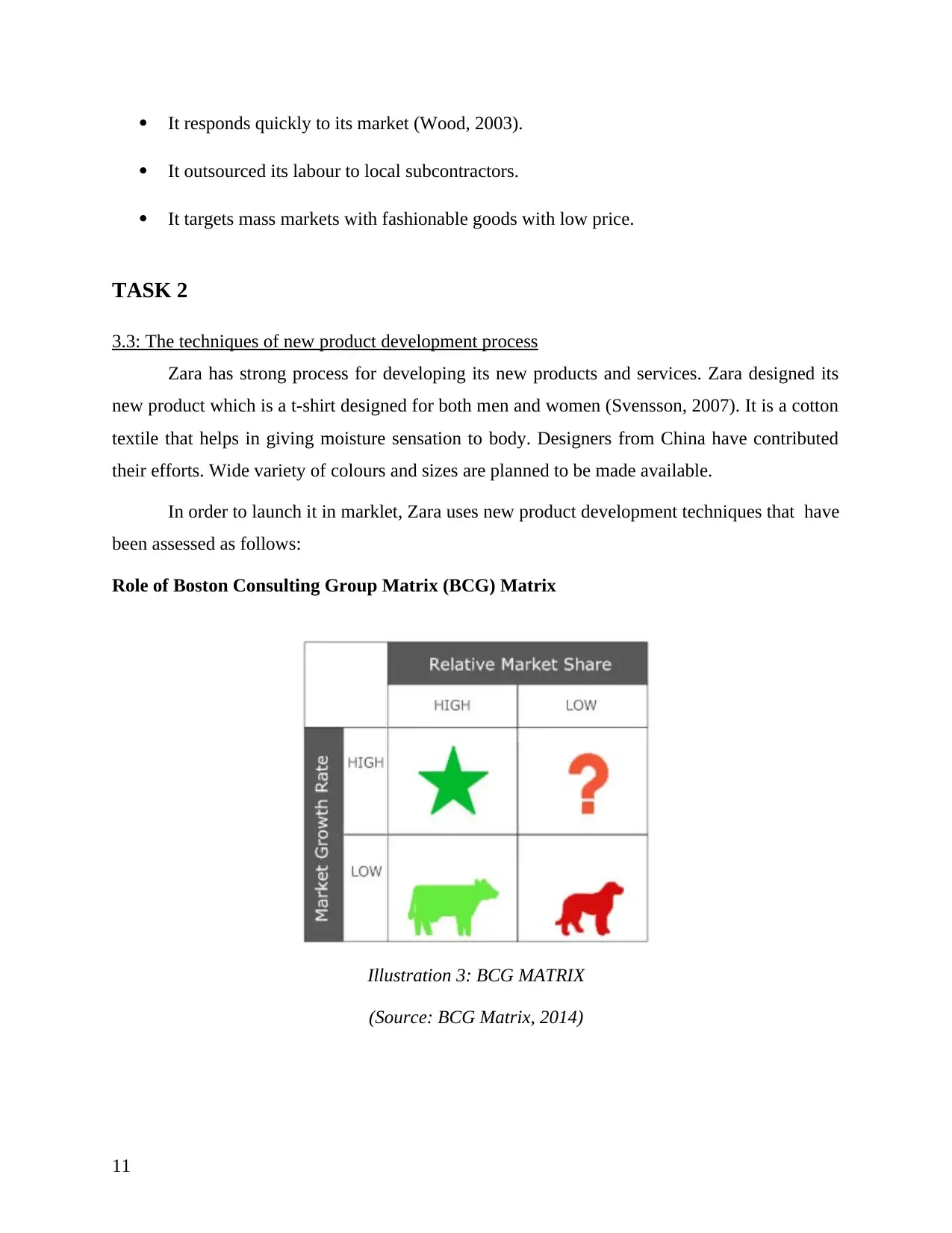
It responds quickly to its market (Wood, 2003).
It outsourced its labour to local subcontractors.
It targets mass markets with fashionable goods with low price.
TASK 2
3.3: The techniques of new product development process
Zara has strong process for developing its new products and services. Zara designed its
new product which is a t-shirt designed for both men and women (Svensson, 2007). It is a cotton
textile that helps in giving moisture sensation to body. Designers from China have contributed
their efforts. Wide variety of colours and sizes are planned to be made available.
In order to launch it in marklet, Zara uses new product development techniques that have
been assessed as follows:
Role of Boston Consulting Group Matrix (BCG) Matrix
11
Illustration 3: BCG MATRIX
(Source: BCG Matrix, 2014)
It outsourced its labour to local subcontractors.
It targets mass markets with fashionable goods with low price.
TASK 2
3.3: The techniques of new product development process
Zara has strong process for developing its new products and services. Zara designed its
new product which is a t-shirt designed for both men and women (Svensson, 2007). It is a cotton
textile that helps in giving moisture sensation to body. Designers from China have contributed
their efforts. Wide variety of colours and sizes are planned to be made available.
In order to launch it in marklet, Zara uses new product development techniques that have
been assessed as follows:
Role of Boston Consulting Group Matrix (BCG) Matrix
11
Illustration 3: BCG MATRIX
(Source: BCG Matrix, 2014)
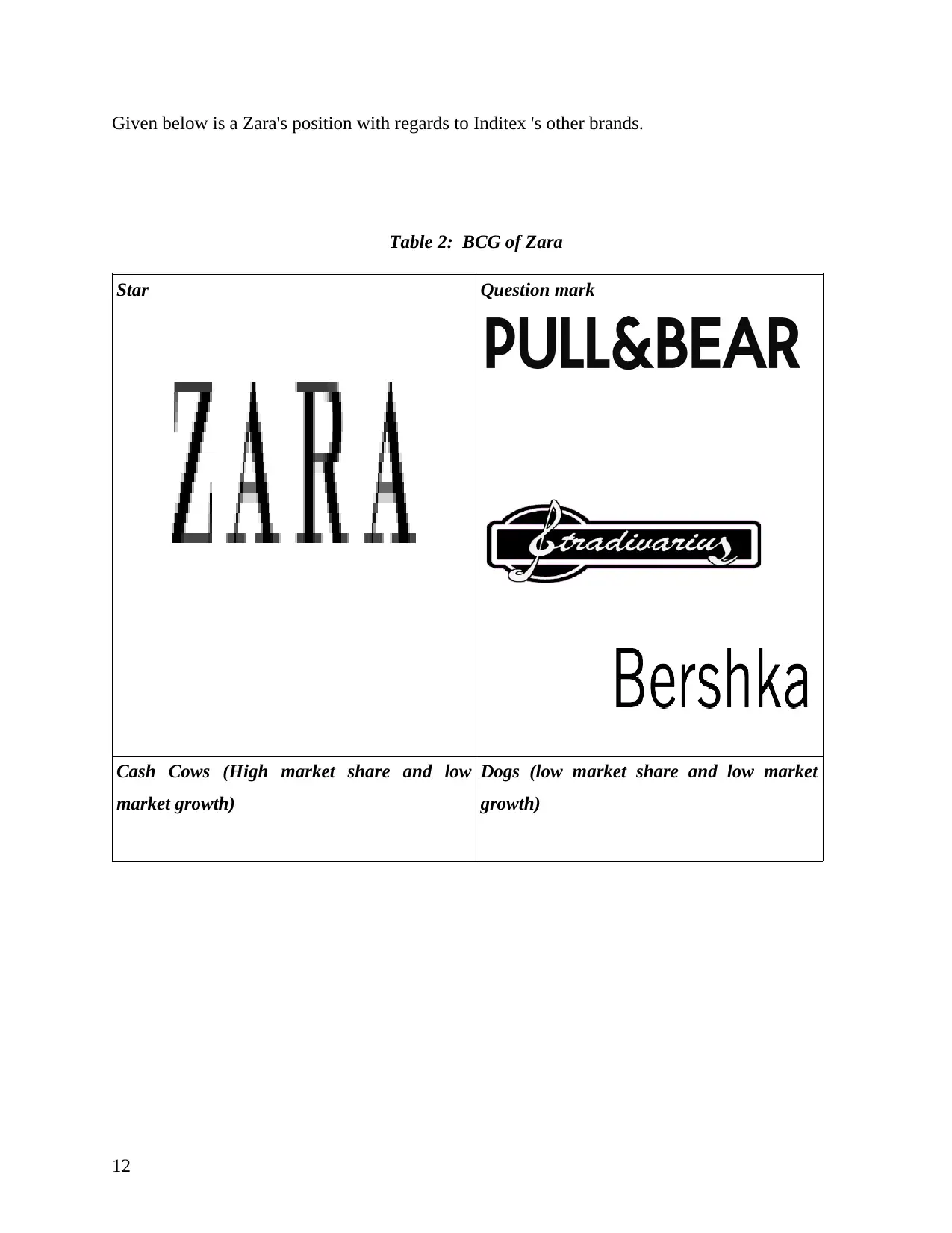
Given below is a Zara's position with regards to Inditex 's other brands.
Table 2: BCG of Zara
Star Question mark
Cash Cows (High market share and low
market growth)
Dogs (low market share and low market
growth)
12
Table 2: BCG of Zara
Star Question mark
Cash Cows (High market share and low
market growth)
Dogs (low market share and low market
growth)
12
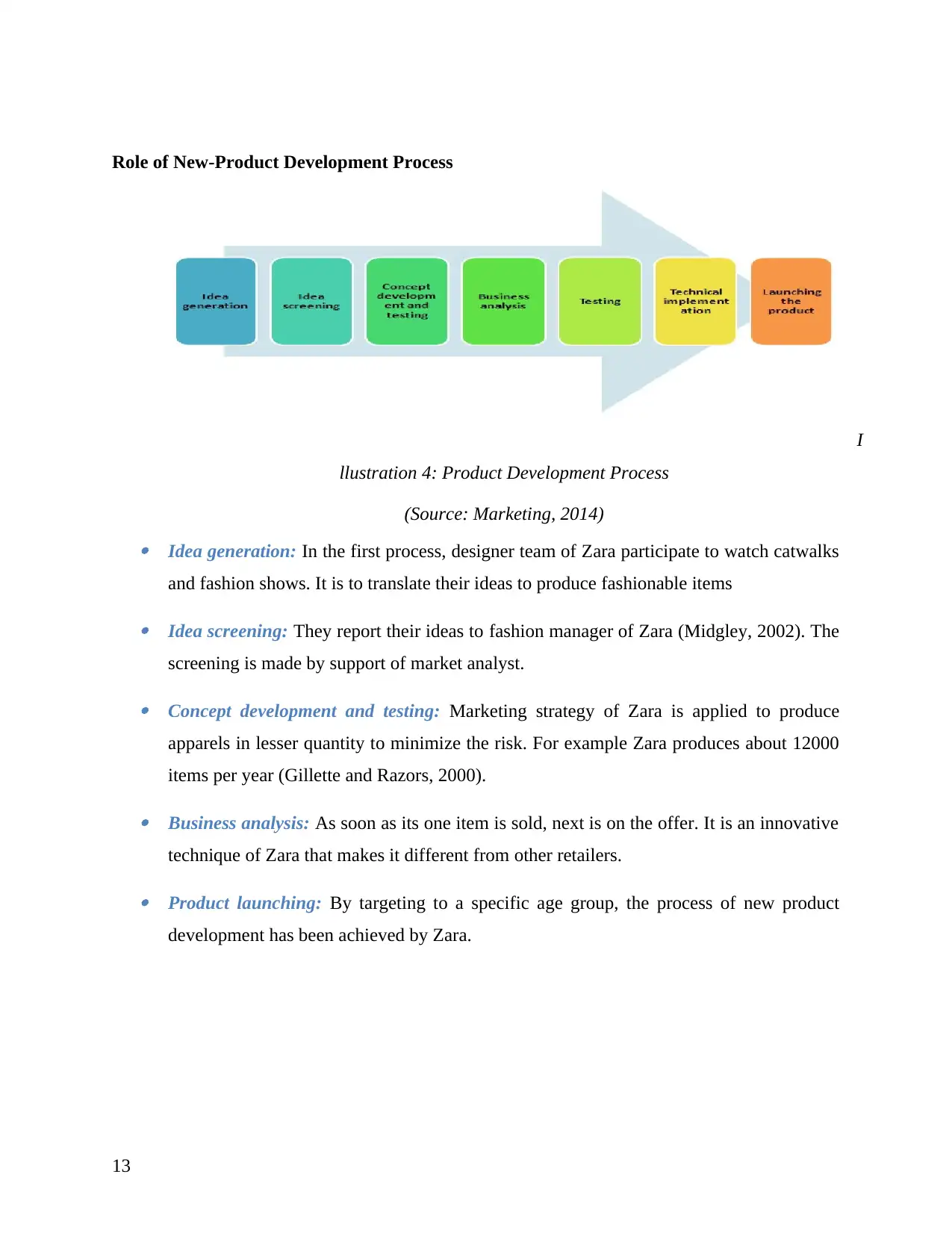
Role of New-Product Development Process
Idea generation: In the first process, designer team of Zara participate to watch catwalks
and fashion shows. It is to translate their ideas to produce fashionable items
Idea screening: They report their ideas to fashion manager of Zara (Midgley, 2002). The
screening is made by support of market analyst.
Concept development and testing: Marketing strategy of Zara is applied to produce
apparels in lesser quantity to minimize the risk. For example Zara produces about 12000
items per year (Gillette and Razors, 2000).
Business analysis: As soon as its one item is sold, next is on the offer. It is an innovative
technique of Zara that makes it different from other retailers.
Product launching: By targeting to a specific age group, the process of new product
development has been achieved by Zara.
13
I
llustration 4: Product Development Process
(Source: Marketing, 2014)
Idea generation: In the first process, designer team of Zara participate to watch catwalks
and fashion shows. It is to translate their ideas to produce fashionable items
Idea screening: They report their ideas to fashion manager of Zara (Midgley, 2002). The
screening is made by support of market analyst.
Concept development and testing: Marketing strategy of Zara is applied to produce
apparels in lesser quantity to minimize the risk. For example Zara produces about 12000
items per year (Gillette and Razors, 2000).
Business analysis: As soon as its one item is sold, next is on the offer. It is an innovative
technique of Zara that makes it different from other retailers.
Product launching: By targeting to a specific age group, the process of new product
development has been achieved by Zara.
13
I
llustration 4: Product Development Process
(Source: Marketing, 2014)
Paraphrase This Document
Need a fresh take? Get an instant paraphrase of this document with our AI Paraphraser
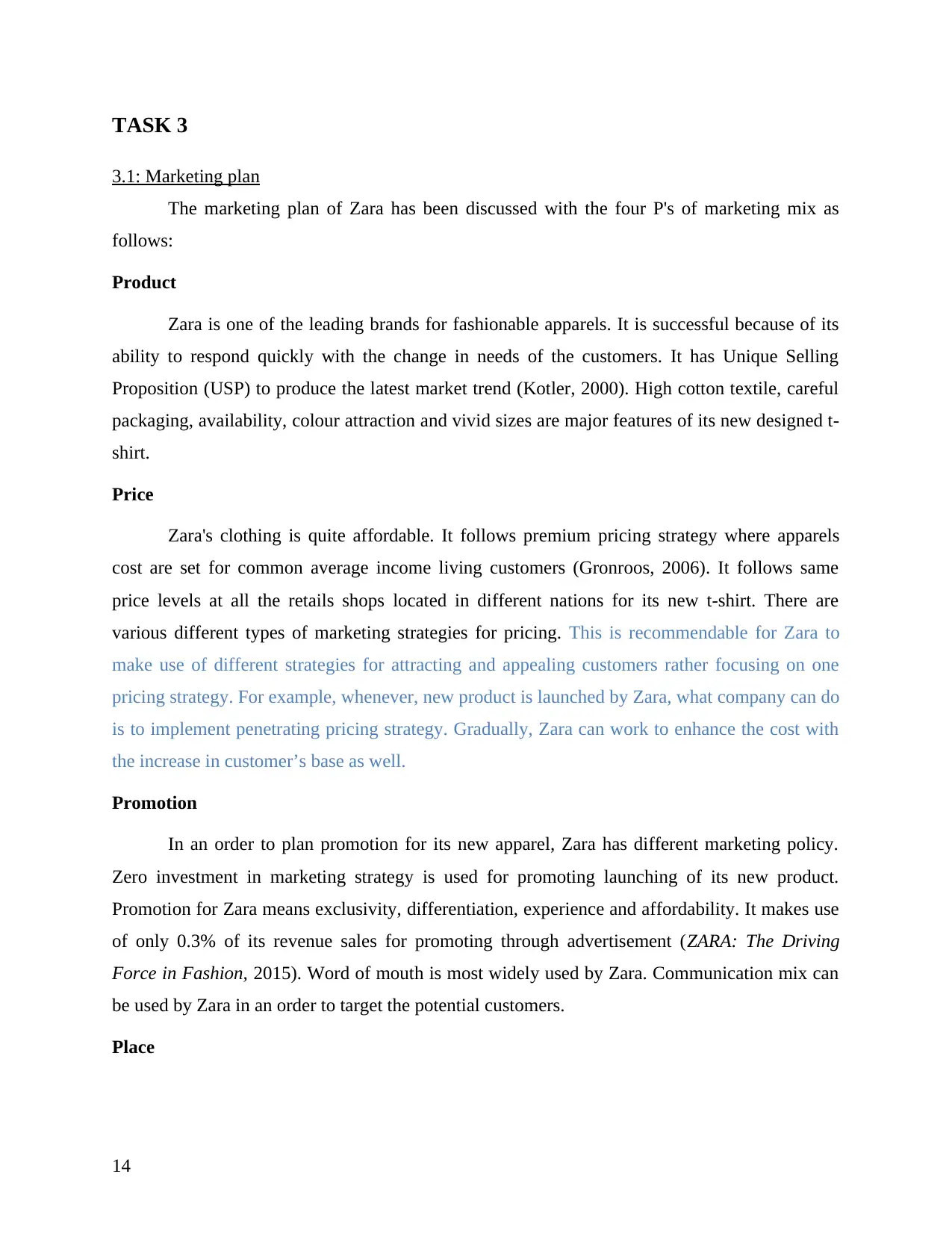
TASK 3
3.1: Marketing plan
The marketing plan of Zara has been discussed with the four P's of marketing mix as
follows:
Product
Zara is one of the leading brands for fashionable apparels. It is successful because of its
ability to respond quickly with the change in needs of the customers. It has Unique Selling
Proposition (USP) to produce the latest market trend (Kotler, 2000). High cotton textile, careful
packaging, availability, colour attraction and vivid sizes are major features of its new designed t-
shirt.
Price
Zara's clothing is quite affordable. It follows premium pricing strategy where apparels
cost are set for common average income living customers (Gronroos, 2006). It follows same
price levels at all the retails shops located in different nations for its new t-shirt. There are
various different types of marketing strategies for pricing. This is recommendable for Zara to
make use of different strategies for attracting and appealing customers rather focusing on one
pricing strategy. For example, whenever, new product is launched by Zara, what company can do
is to implement penetrating pricing strategy. Gradually, Zara can work to enhance the cost with
the increase in customer’s base as well.
Promotion
In an order to plan promotion for its new apparel, Zara has different marketing policy.
Zero investment in marketing strategy is used for promoting launching of its new product.
Promotion for Zara means exclusivity, differentiation, experience and affordability. It makes use
of only 0.3% of its revenue sales for promoting through advertisement (ZARA: The Driving
Force in Fashion, 2015). Word of mouth is most widely used by Zara. Communication mix can
be used by Zara in an order to target the potential customers.
Place
14
3.1: Marketing plan
The marketing plan of Zara has been discussed with the four P's of marketing mix as
follows:
Product
Zara is one of the leading brands for fashionable apparels. It is successful because of its
ability to respond quickly with the change in needs of the customers. It has Unique Selling
Proposition (USP) to produce the latest market trend (Kotler, 2000). High cotton textile, careful
packaging, availability, colour attraction and vivid sizes are major features of its new designed t-
shirt.
Price
Zara's clothing is quite affordable. It follows premium pricing strategy where apparels
cost are set for common average income living customers (Gronroos, 2006). It follows same
price levels at all the retails shops located in different nations for its new t-shirt. There are
various different types of marketing strategies for pricing. This is recommendable for Zara to
make use of different strategies for attracting and appealing customers rather focusing on one
pricing strategy. For example, whenever, new product is launched by Zara, what company can do
is to implement penetrating pricing strategy. Gradually, Zara can work to enhance the cost with
the increase in customer’s base as well.
Promotion
In an order to plan promotion for its new apparel, Zara has different marketing policy.
Zero investment in marketing strategy is used for promoting launching of its new product.
Promotion for Zara means exclusivity, differentiation, experience and affordability. It makes use
of only 0.3% of its revenue sales for promoting through advertisement (ZARA: The Driving
Force in Fashion, 2015). Word of mouth is most widely used by Zara. Communication mix can
be used by Zara in an order to target the potential customers.
Place
14
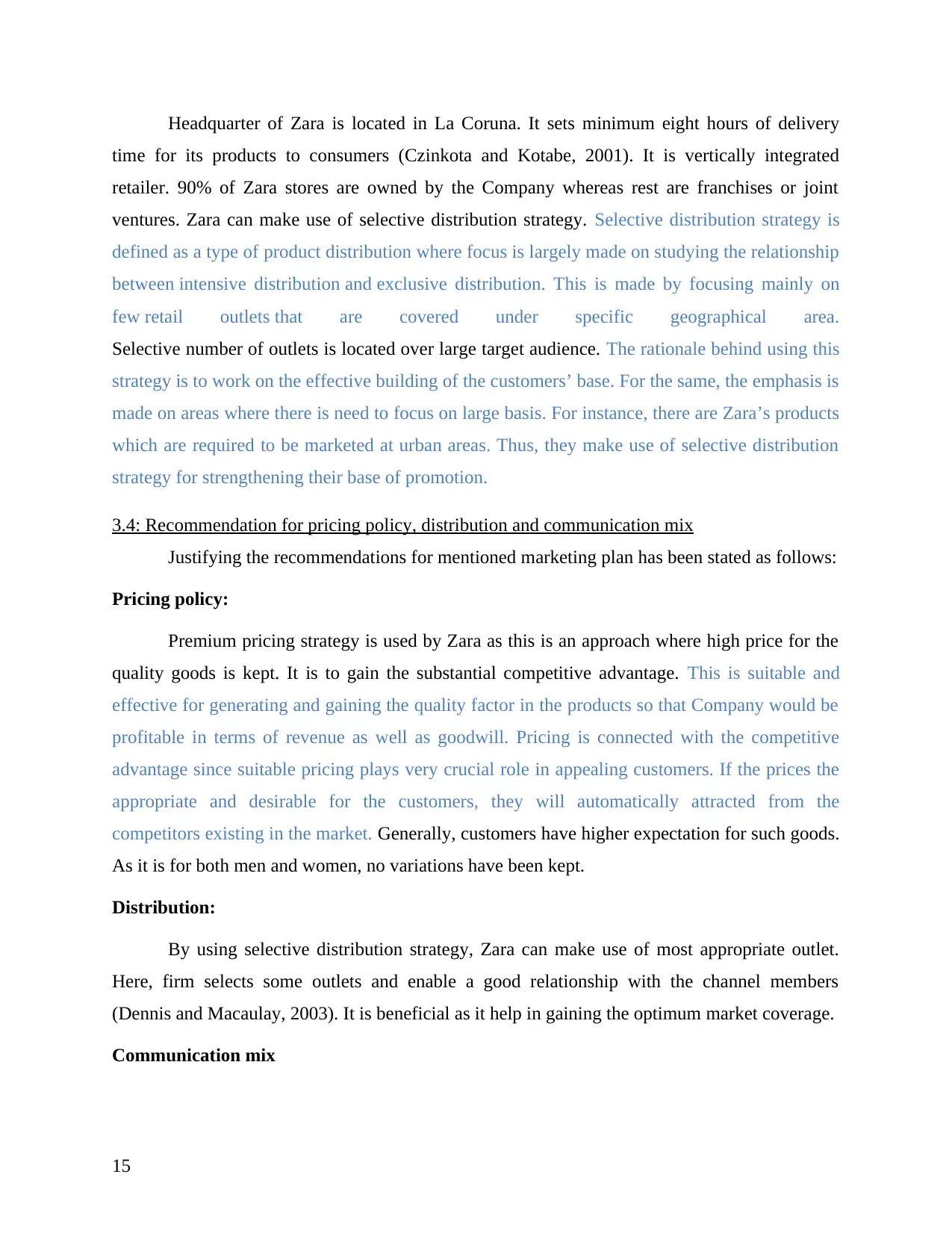
Headquarter of Zara is located in La Coruna. It sets minimum eight hours of delivery
time for its products to consumers (Czinkota and Kotabe, 2001). It is vertically integrated
retailer. 90% of Zara stores are owned by the Company whereas rest are franchises or joint
ventures. Zara can make use of selective distribution strategy. Selective distribution strategy is
defined as a type of product distribution where focus is largely made on studying the relationship
between intensive distribution and exclusive distribution. This is made by focusing mainly on
few retail outlets that are covered under specific geographical area.
Selective number of outlets is located over large target audience. The rationale behind using this
strategy is to work on the effective building of the customers’ base. For the same, the emphasis is
made on areas where there is need to focus on large basis. For instance, there are Zara’s products
which are required to be marketed at urban areas. Thus, they make use of selective distribution
strategy for strengthening their base of promotion.
3.4: Recommendation for pricing policy, distribution and communication mix
Justifying the recommendations for mentioned marketing plan has been stated as follows:
Pricing policy:
Premium pricing strategy is used by Zara as this is an approach where high price for the
quality goods is kept. It is to gain the substantial competitive advantage. This is suitable and
effective for generating and gaining the quality factor in the products so that Company would be
profitable in terms of revenue as well as goodwill. Pricing is connected with the competitive
advantage since suitable pricing plays very crucial role in appealing customers. If the prices the
appropriate and desirable for the customers, they will automatically attracted from the
competitors existing in the market. Generally, customers have higher expectation for such goods.
As it is for both men and women, no variations have been kept.
Distribution:
By using selective distribution strategy, Zara can make use of most appropriate outlet.
Here, firm selects some outlets and enable a good relationship with the channel members
(Dennis and Macaulay, 2003). It is beneficial as it help in gaining the optimum market coverage.
Communication mix
15
time for its products to consumers (Czinkota and Kotabe, 2001). It is vertically integrated
retailer. 90% of Zara stores are owned by the Company whereas rest are franchises or joint
ventures. Zara can make use of selective distribution strategy. Selective distribution strategy is
defined as a type of product distribution where focus is largely made on studying the relationship
between intensive distribution and exclusive distribution. This is made by focusing mainly on
few retail outlets that are covered under specific geographical area.
Selective number of outlets is located over large target audience. The rationale behind using this
strategy is to work on the effective building of the customers’ base. For the same, the emphasis is
made on areas where there is need to focus on large basis. For instance, there are Zara’s products
which are required to be marketed at urban areas. Thus, they make use of selective distribution
strategy for strengthening their base of promotion.
3.4: Recommendation for pricing policy, distribution and communication mix
Justifying the recommendations for mentioned marketing plan has been stated as follows:
Pricing policy:
Premium pricing strategy is used by Zara as this is an approach where high price for the
quality goods is kept. It is to gain the substantial competitive advantage. This is suitable and
effective for generating and gaining the quality factor in the products so that Company would be
profitable in terms of revenue as well as goodwill. Pricing is connected with the competitive
advantage since suitable pricing plays very crucial role in appealing customers. If the prices the
appropriate and desirable for the customers, they will automatically attracted from the
competitors existing in the market. Generally, customers have higher expectation for such goods.
As it is for both men and women, no variations have been kept.
Distribution:
By using selective distribution strategy, Zara can make use of most appropriate outlet.
Here, firm selects some outlets and enable a good relationship with the channel members
(Dennis and Macaulay, 2003). It is beneficial as it help in gaining the optimum market coverage.
Communication mix
15
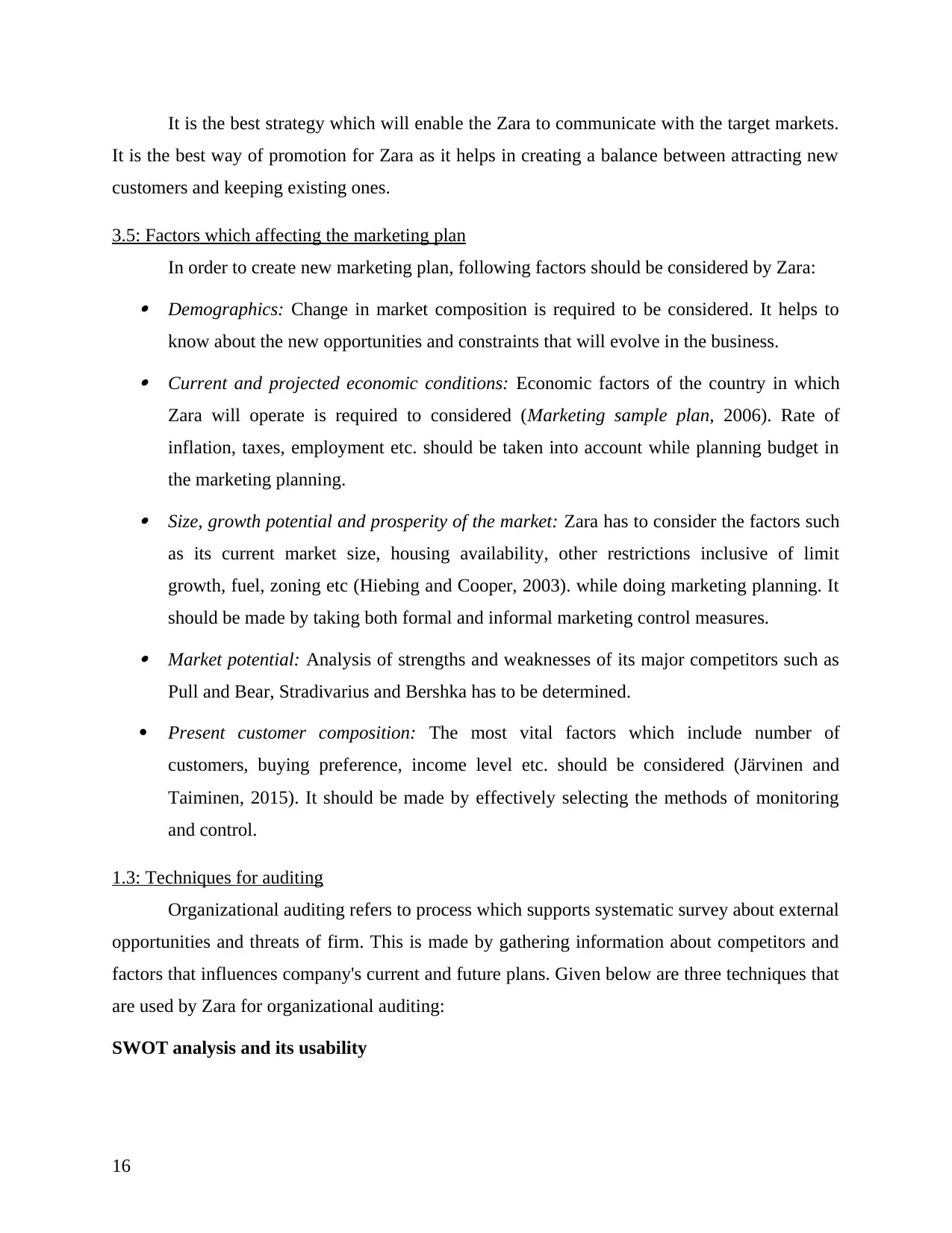
It is the best strategy which will enable the Zara to communicate with the target markets.
It is the best way of promotion for Zara as it helps in creating a balance between attracting new
customers and keeping existing ones.
3.5: Factors which affecting the marketing plan
In order to create new marketing plan, following factors should be considered by Zara: Demographics: Change in market composition is required to be considered. It helps to
know about the new opportunities and constraints that will evolve in the business. Current and projected economic conditions: Economic factors of the country in which
Zara will operate is required to considered (Marketing sample plan, 2006). Rate of
inflation, taxes, employment etc. should be taken into account while planning budget in
the marketing planning. Size, growth potential and prosperity of the market: Zara has to consider the factors such
as its current market size, housing availability, other restrictions inclusive of limit
growth, fuel, zoning etc (Hiebing and Cooper, 2003). while doing marketing planning. It
should be made by taking both formal and informal marketing control measures. Market potential: Analysis of strengths and weaknesses of its major competitors such as
Pull and Bear, Stradivarius and Bershka has to be determined.
Present customer composition: The most vital factors which include number of
customers, buying preference, income level etc. should be considered (Järvinen and
Taiminen, 2015). It should be made by effectively selecting the methods of monitoring
and control.
1.3: Techniques for auditing
Organizational auditing refers to process which supports systematic survey about external
opportunities and threats of firm. This is made by gathering information about competitors and
factors that influences company's current and future plans. Given below are three techniques that
are used by Zara for organizational auditing:
SWOT analysis and its usability
16
It is the best way of promotion for Zara as it helps in creating a balance between attracting new
customers and keeping existing ones.
3.5: Factors which affecting the marketing plan
In order to create new marketing plan, following factors should be considered by Zara: Demographics: Change in market composition is required to be considered. It helps to
know about the new opportunities and constraints that will evolve in the business. Current and projected economic conditions: Economic factors of the country in which
Zara will operate is required to considered (Marketing sample plan, 2006). Rate of
inflation, taxes, employment etc. should be taken into account while planning budget in
the marketing planning. Size, growth potential and prosperity of the market: Zara has to consider the factors such
as its current market size, housing availability, other restrictions inclusive of limit
growth, fuel, zoning etc (Hiebing and Cooper, 2003). while doing marketing planning. It
should be made by taking both formal and informal marketing control measures. Market potential: Analysis of strengths and weaknesses of its major competitors such as
Pull and Bear, Stradivarius and Bershka has to be determined.
Present customer composition: The most vital factors which include number of
customers, buying preference, income level etc. should be considered (Järvinen and
Taiminen, 2015). It should be made by effectively selecting the methods of monitoring
and control.
1.3: Techniques for auditing
Organizational auditing refers to process which supports systematic survey about external
opportunities and threats of firm. This is made by gathering information about competitors and
factors that influences company's current and future plans. Given below are three techniques that
are used by Zara for organizational auditing:
SWOT analysis and its usability
16
Secure Best Marks with AI Grader
Need help grading? Try our AI Grader for instant feedback on your assignments.
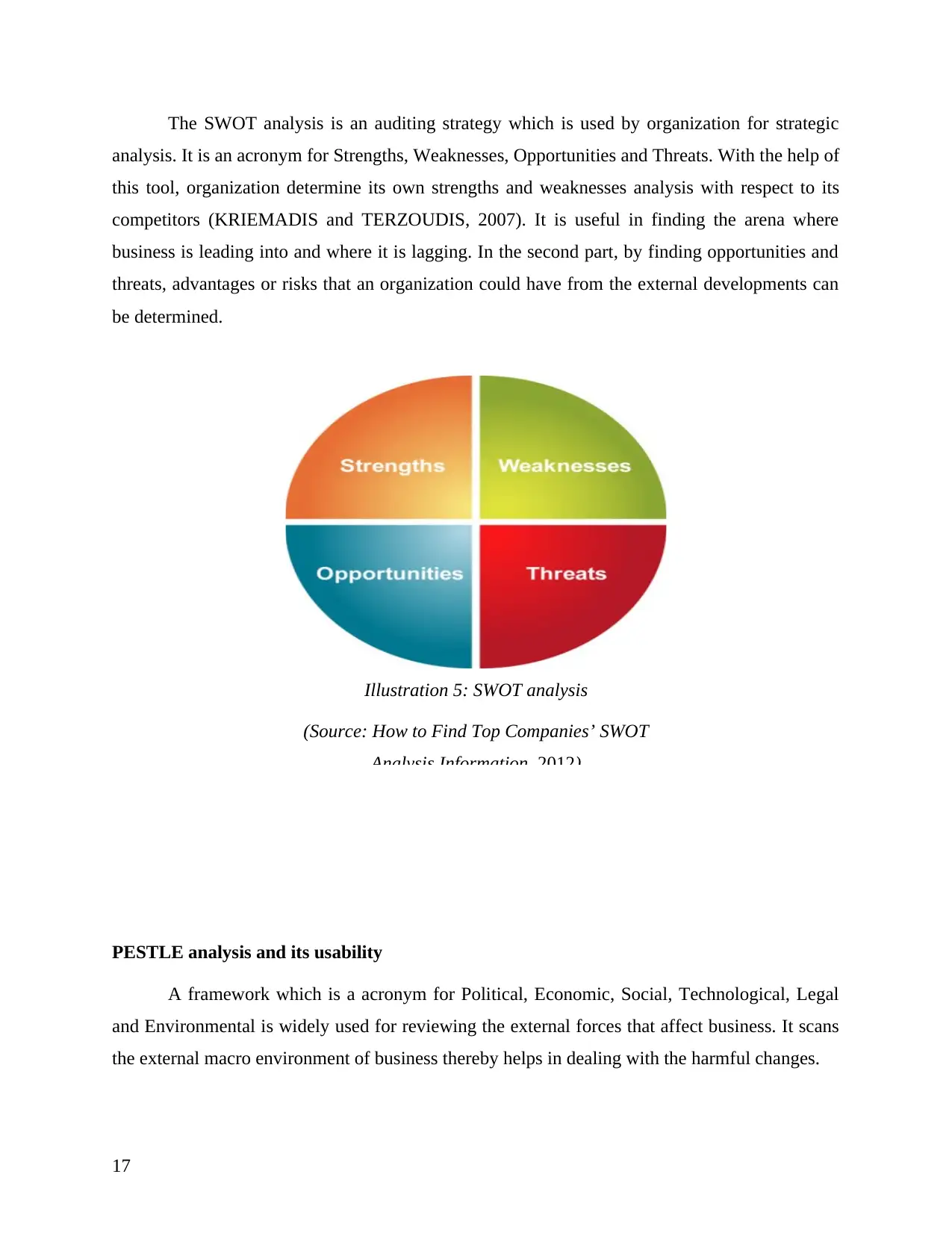
The SWOT analysis is an auditing strategy which is used by organization for strategic
analysis. It is an acronym for Strengths, Weaknesses, Opportunities and Threats. With the help of
this tool, organization determine its own strengths and weaknesses analysis with respect to its
competitors (KRIEMADIS and TERZOUDIS, 2007). It is useful in finding the arena where
business is leading into and where it is lagging. In the second part, by finding opportunities and
threats, advantages or risks that an organization could have from the external developments can
be determined.
PESTLE analysis and its usability
A framework which is a acronym for Political, Economic, Social, Technological, Legal
and Environmental is widely used for reviewing the external forces that affect business. It scans
the external macro environment of business thereby helps in dealing with the harmful changes.
17
Illustration 5: SWOT analysis
(Source: How to Find Top Companies’ SWOT
Analysis Information, 2012)
analysis. It is an acronym for Strengths, Weaknesses, Opportunities and Threats. With the help of
this tool, organization determine its own strengths and weaknesses analysis with respect to its
competitors (KRIEMADIS and TERZOUDIS, 2007). It is useful in finding the arena where
business is leading into and where it is lagging. In the second part, by finding opportunities and
threats, advantages or risks that an organization could have from the external developments can
be determined.
PESTLE analysis and its usability
A framework which is a acronym for Political, Economic, Social, Technological, Legal
and Environmental is widely used for reviewing the external forces that affect business. It scans
the external macro environment of business thereby helps in dealing with the harmful changes.
17
Illustration 5: SWOT analysis
(Source: How to Find Top Companies’ SWOT
Analysis Information, 2012)
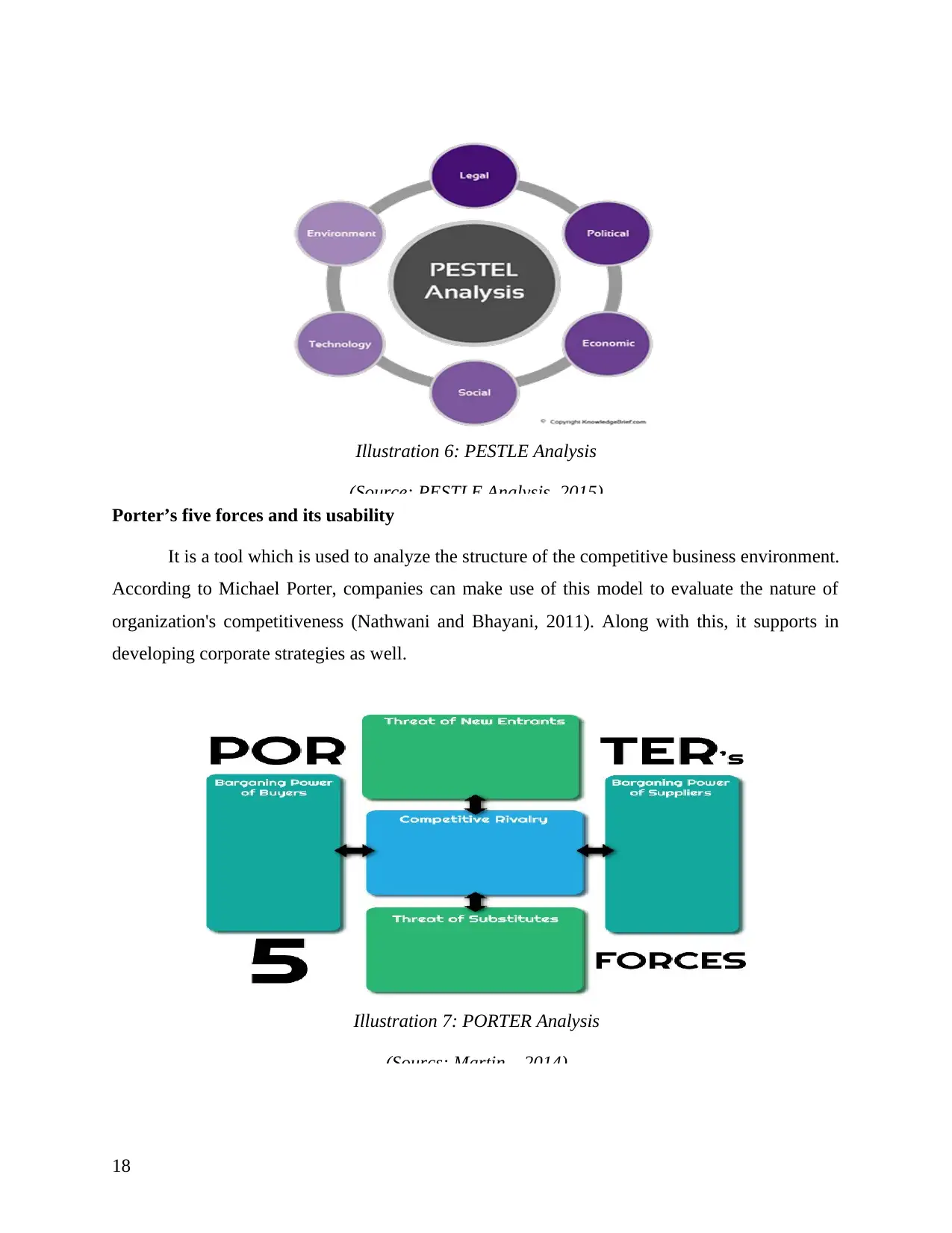
Porter’s five forces and its usability
It is a tool which is used to analyze the structure of the competitive business environment.
According to Michael Porter, companies can make use of this model to evaluate the nature of
organization's competitiveness (Nathwani and Bhayani, 2011). Along with this, it supports in
developing corporate strategies as well.
18
Illustration 6: PESTLE Analysis
(Source: PESTLE Analysis, 2015)
Illustration 7: PORTER Analysis
(Sourcs: Martin., 2014)
It is a tool which is used to analyze the structure of the competitive business environment.
According to Michael Porter, companies can make use of this model to evaluate the nature of
organization's competitiveness (Nathwani and Bhayani, 2011). Along with this, it supports in
developing corporate strategies as well.
18
Illustration 6: PESTLE Analysis
(Source: PESTLE Analysis, 2015)
Illustration 7: PORTER Analysis
(Sourcs: Martin., 2014)
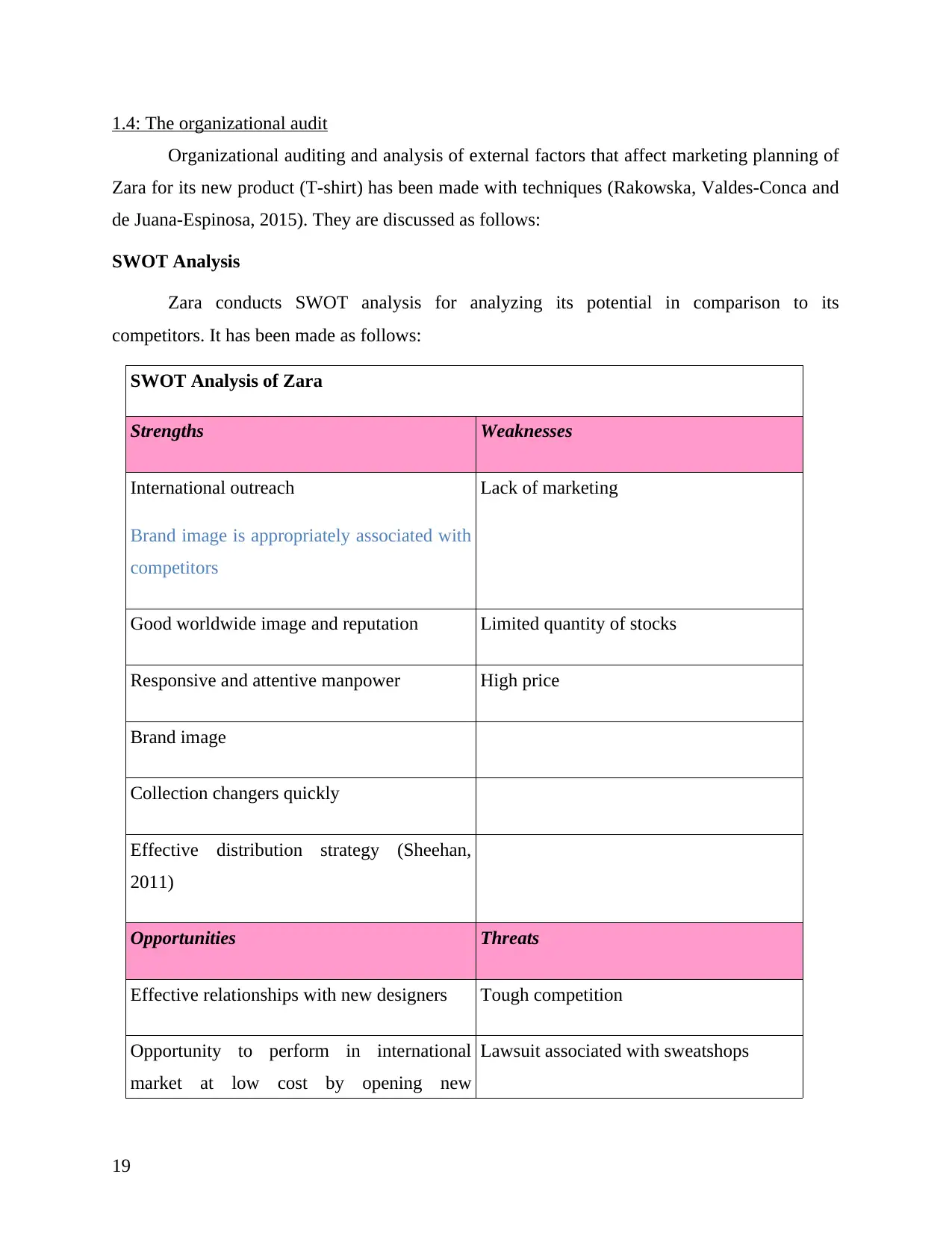
1.4: The organizational audit
Organizational auditing and analysis of external factors that affect marketing planning of
Zara for its new product (T-shirt) has been made with techniques (Rakowska, Valdes-Conca and
de Juana-Espinosa, 2015). They are discussed as follows:
SWOT Analysis
Zara conducts SWOT analysis for analyzing its potential in comparison to its
competitors. It has been made as follows:
SWOT Analysis of Zara
Strengths Weaknesses
International outreach
Brand image is appropriately associated with
competitors
Lack of marketing
Good worldwide image and reputation Limited quantity of stocks
Responsive and attentive manpower High price
Brand image
Collection changers quickly
Effective distribution strategy (Sheehan,
2011)
Opportunities Threats
Effective relationships with new designers Tough competition
Opportunity to perform in international
market at low cost by opening new
Lawsuit associated with sweatshops
19
Organizational auditing and analysis of external factors that affect marketing planning of
Zara for its new product (T-shirt) has been made with techniques (Rakowska, Valdes-Conca and
de Juana-Espinosa, 2015). They are discussed as follows:
SWOT Analysis
Zara conducts SWOT analysis for analyzing its potential in comparison to its
competitors. It has been made as follows:
SWOT Analysis of Zara
Strengths Weaknesses
International outreach
Brand image is appropriately associated with
competitors
Lack of marketing
Good worldwide image and reputation Limited quantity of stocks
Responsive and attentive manpower High price
Brand image
Collection changers quickly
Effective distribution strategy (Sheehan,
2011)
Opportunities Threats
Effective relationships with new designers Tough competition
Opportunity to perform in international
market at low cost by opening new
Lawsuit associated with sweatshops
19
Paraphrase This Document
Need a fresh take? Get an instant paraphrase of this document with our AI Paraphraser
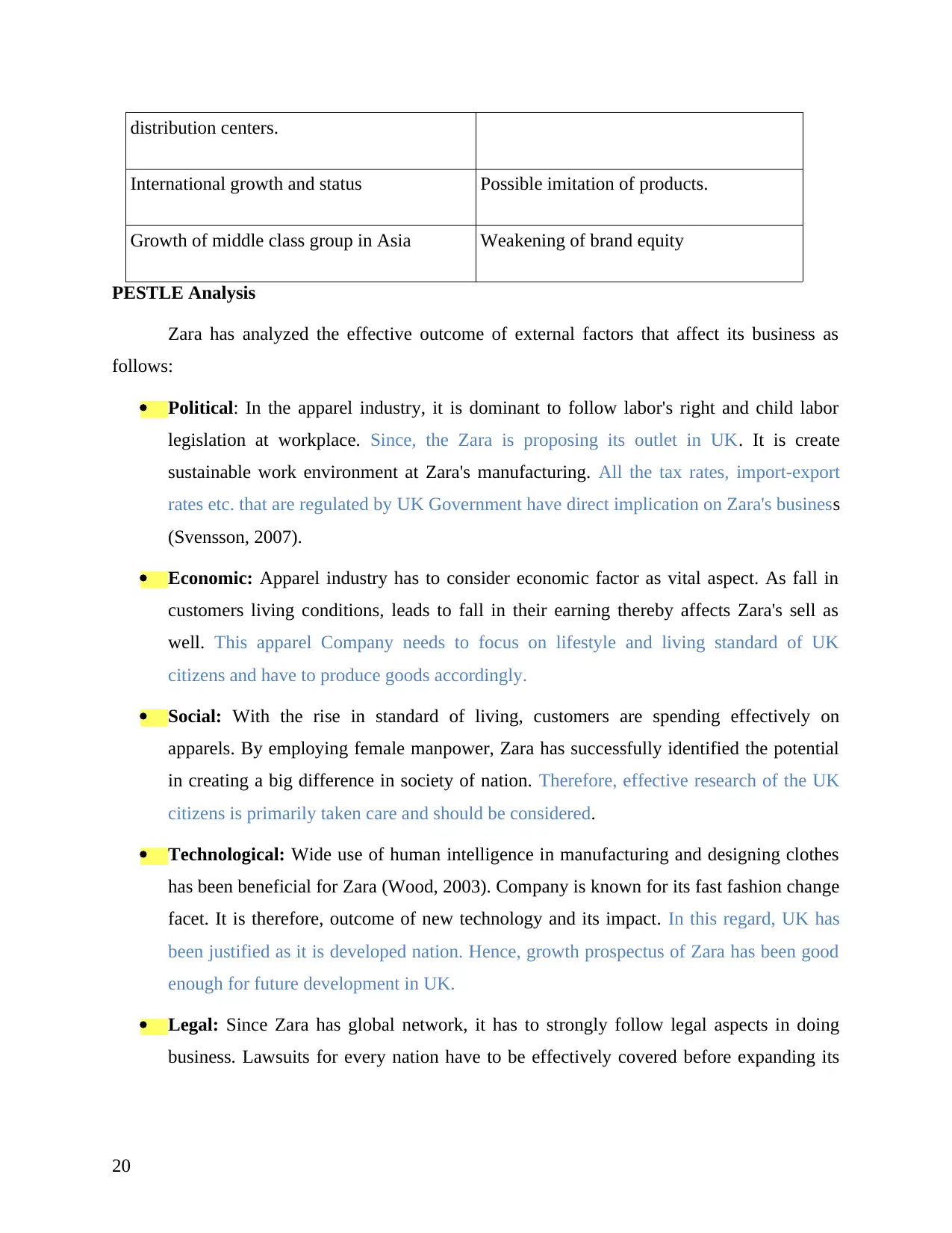
distribution centers.
International growth and status Possible imitation of products.
Growth of middle class group in Asia Weakening of brand equity
PESTLE Analysis
Zara has analyzed the effective outcome of external factors that affect its business as
follows:
Political: In the apparel industry, it is dominant to follow labor's right and child labor
legislation at workplace. Since, the Zara is proposing its outlet in UK. It is create
sustainable work environment at Zara's manufacturing. All the tax rates, import-export
rates etc. that are regulated by UK Government have direct implication on Zara's business
(Svensson, 2007).
Economic: Apparel industry has to consider economic factor as vital aspect. As fall in
customers living conditions, leads to fall in their earning thereby affects Zara's sell as
well. This apparel Company needs to focus on lifestyle and living standard of UK
citizens and have to produce goods accordingly.
Social: With the rise in standard of living, customers are spending effectively on
apparels. By employing female manpower, Zara has successfully identified the potential
in creating a big difference in society of nation. Therefore, effective research of the UK
citizens is primarily taken care and should be considered.
Technological: Wide use of human intelligence in manufacturing and designing clothes
has been beneficial for Zara (Wood, 2003). Company is known for its fast fashion change
facet. It is therefore, outcome of new technology and its impact. In this regard, UK has
been justified as it is developed nation. Hence, growth prospectus of Zara has been good
enough for future development in UK.
Legal: Since Zara has global network, it has to strongly follow legal aspects in doing
business. Lawsuits for every nation have to be effectively covered before expanding its
20
International growth and status Possible imitation of products.
Growth of middle class group in Asia Weakening of brand equity
PESTLE Analysis
Zara has analyzed the effective outcome of external factors that affect its business as
follows:
Political: In the apparel industry, it is dominant to follow labor's right and child labor
legislation at workplace. Since, the Zara is proposing its outlet in UK. It is create
sustainable work environment at Zara's manufacturing. All the tax rates, import-export
rates etc. that are regulated by UK Government have direct implication on Zara's business
(Svensson, 2007).
Economic: Apparel industry has to consider economic factor as vital aspect. As fall in
customers living conditions, leads to fall in their earning thereby affects Zara's sell as
well. This apparel Company needs to focus on lifestyle and living standard of UK
citizens and have to produce goods accordingly.
Social: With the rise in standard of living, customers are spending effectively on
apparels. By employing female manpower, Zara has successfully identified the potential
in creating a big difference in society of nation. Therefore, effective research of the UK
citizens is primarily taken care and should be considered.
Technological: Wide use of human intelligence in manufacturing and designing clothes
has been beneficial for Zara (Wood, 2003). Company is known for its fast fashion change
facet. It is therefore, outcome of new technology and its impact. In this regard, UK has
been justified as it is developed nation. Hence, growth prospectus of Zara has been good
enough for future development in UK.
Legal: Since Zara has global network, it has to strongly follow legal aspects in doing
business. Lawsuits for every nation have to be effectively covered before expanding its
20
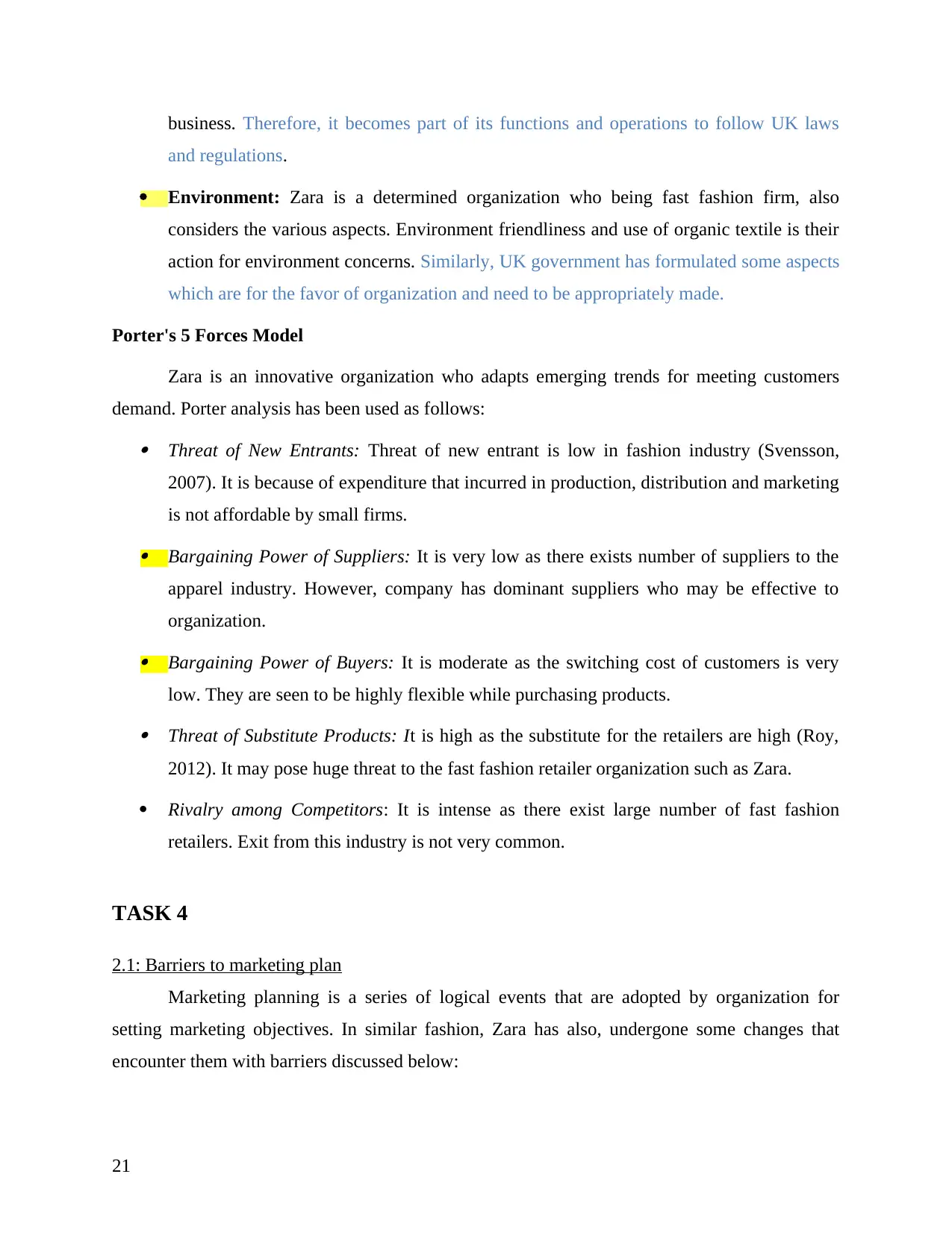
business. Therefore, it becomes part of its functions and operations to follow UK laws
and regulations.
Environment: Zara is a determined organization who being fast fashion firm, also
considers the various aspects. Environment friendliness and use of organic textile is their
action for environment concerns. Similarly, UK government has formulated some aspects
which are for the favor of organization and need to be appropriately made.
Porter's 5 Forces Model
Zara is an innovative organization who adapts emerging trends for meeting customers
demand. Porter analysis has been used as follows: Threat of New Entrants: Threat of new entrant is low in fashion industry (Svensson,
2007). It is because of expenditure that incurred in production, distribution and marketing
is not affordable by small firms. Bargaining Power of Suppliers: It is very low as there exists number of suppliers to the
apparel industry. However, company has dominant suppliers who may be effective to
organization. Bargaining Power of Buyers: It is moderate as the switching cost of customers is very
low. They are seen to be highly flexible while purchasing products. Threat of Substitute Products: It is high as the substitute for the retailers are high (Roy,
2012). It may pose huge threat to the fast fashion retailer organization such as Zara.
Rivalry among Competitors: It is intense as there exist large number of fast fashion
retailers. Exit from this industry is not very common.
TASK 4
2.1: Barriers to marketing plan
Marketing planning is a series of logical events that are adopted by organization for
setting marketing objectives. In similar fashion, Zara has also, undergone some changes that
encounter them with barriers discussed below:
21
and regulations.
Environment: Zara is a determined organization who being fast fashion firm, also
considers the various aspects. Environment friendliness and use of organic textile is their
action for environment concerns. Similarly, UK government has formulated some aspects
which are for the favor of organization and need to be appropriately made.
Porter's 5 Forces Model
Zara is an innovative organization who adapts emerging trends for meeting customers
demand. Porter analysis has been used as follows: Threat of New Entrants: Threat of new entrant is low in fashion industry (Svensson,
2007). It is because of expenditure that incurred in production, distribution and marketing
is not affordable by small firms. Bargaining Power of Suppliers: It is very low as there exists number of suppliers to the
apparel industry. However, company has dominant suppliers who may be effective to
organization. Bargaining Power of Buyers: It is moderate as the switching cost of customers is very
low. They are seen to be highly flexible while purchasing products. Threat of Substitute Products: It is high as the substitute for the retailers are high (Roy,
2012). It may pose huge threat to the fast fashion retailer organization such as Zara.
Rivalry among Competitors: It is intense as there exist large number of fast fashion
retailers. Exit from this industry is not very common.
TASK 4
2.1: Barriers to marketing plan
Marketing planning is a series of logical events that are adopted by organization for
setting marketing objectives. In similar fashion, Zara has also, undergone some changes that
encounter them with barriers discussed below:
21
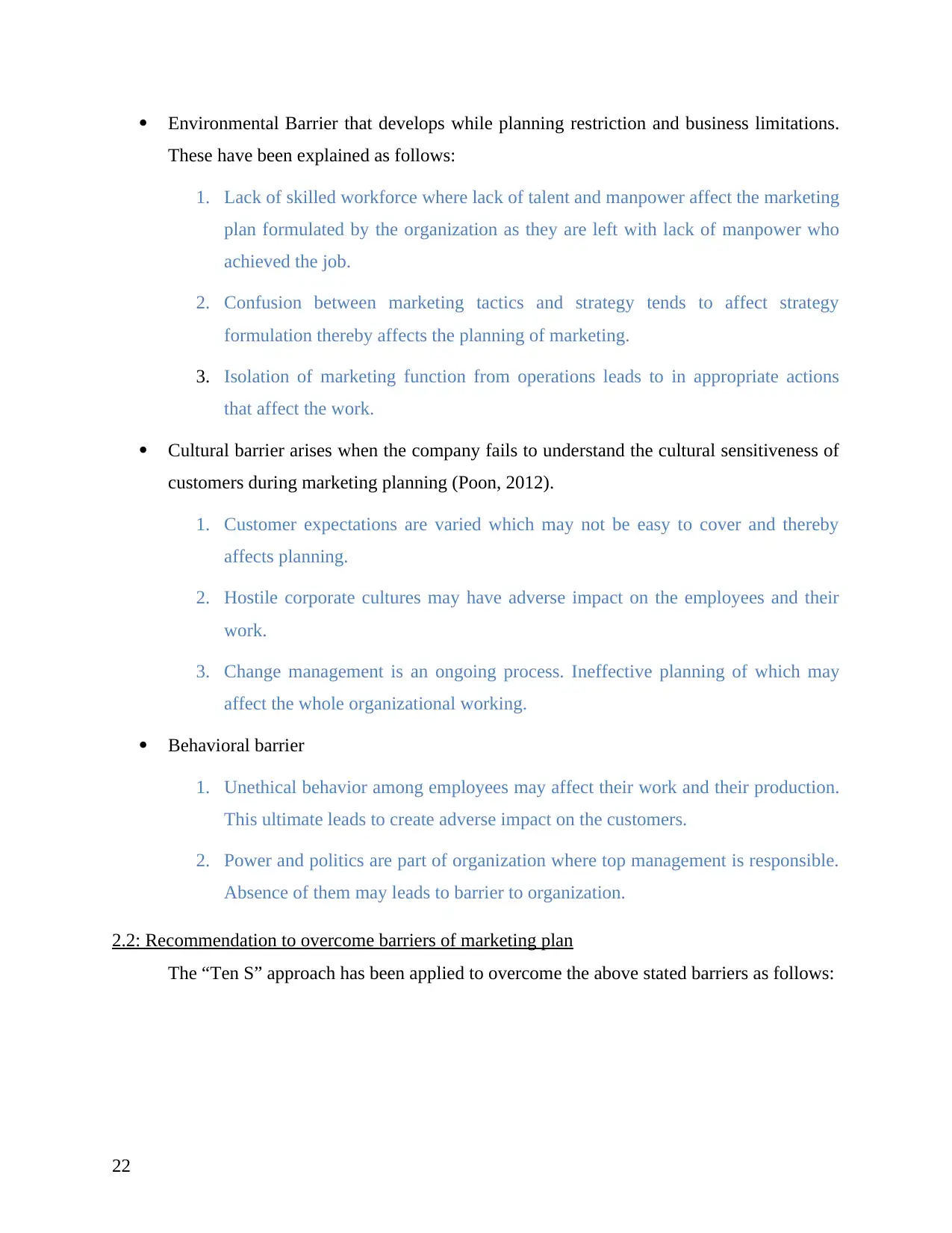
Environmental Barrier that develops while planning restriction and business limitations.
These have been explained as follows:
1. Lack of skilled workforce where lack of talent and manpower affect the marketing
plan formulated by the organization as they are left with lack of manpower who
achieved the job.
2. Confusion between marketing tactics and strategy tends to affect strategy
formulation thereby affects the planning of marketing.
3. Isolation of marketing function from operations leads to in appropriate actions
that affect the work.
Cultural barrier arises when the company fails to understand the cultural sensitiveness of
customers during marketing planning (Poon, 2012).
1. Customer expectations are varied which may not be easy to cover and thereby
affects planning.
2. Hostile corporate cultures may have adverse impact on the employees and their
work.
3. Change management is an ongoing process. Ineffective planning of which may
affect the whole organizational working.
Behavioral barrier
1. Unethical behavior among employees may affect their work and their production.
This ultimate leads to create adverse impact on the customers.
2. Power and politics are part of organization where top management is responsible.
Absence of them may leads to barrier to organization.
2.2: Recommendation to overcome barriers of marketing plan
The “Ten S” approach has been applied to overcome the above stated barriers as follows:
22
These have been explained as follows:
1. Lack of skilled workforce where lack of talent and manpower affect the marketing
plan formulated by the organization as they are left with lack of manpower who
achieved the job.
2. Confusion between marketing tactics and strategy tends to affect strategy
formulation thereby affects the planning of marketing.
3. Isolation of marketing function from operations leads to in appropriate actions
that affect the work.
Cultural barrier arises when the company fails to understand the cultural sensitiveness of
customers during marketing planning (Poon, 2012).
1. Customer expectations are varied which may not be easy to cover and thereby
affects planning.
2. Hostile corporate cultures may have adverse impact on the employees and their
work.
3. Change management is an ongoing process. Ineffective planning of which may
affect the whole organizational working.
Behavioral barrier
1. Unethical behavior among employees may affect their work and their production.
This ultimate leads to create adverse impact on the customers.
2. Power and politics are part of organization where top management is responsible.
Absence of them may leads to barrier to organization.
2.2: Recommendation to overcome barriers of marketing plan
The “Ten S” approach has been applied to overcome the above stated barriers as follows:
22
Secure Best Marks with AI Grader
Need help grading? Try our AI Grader for instant feedback on your assignments.
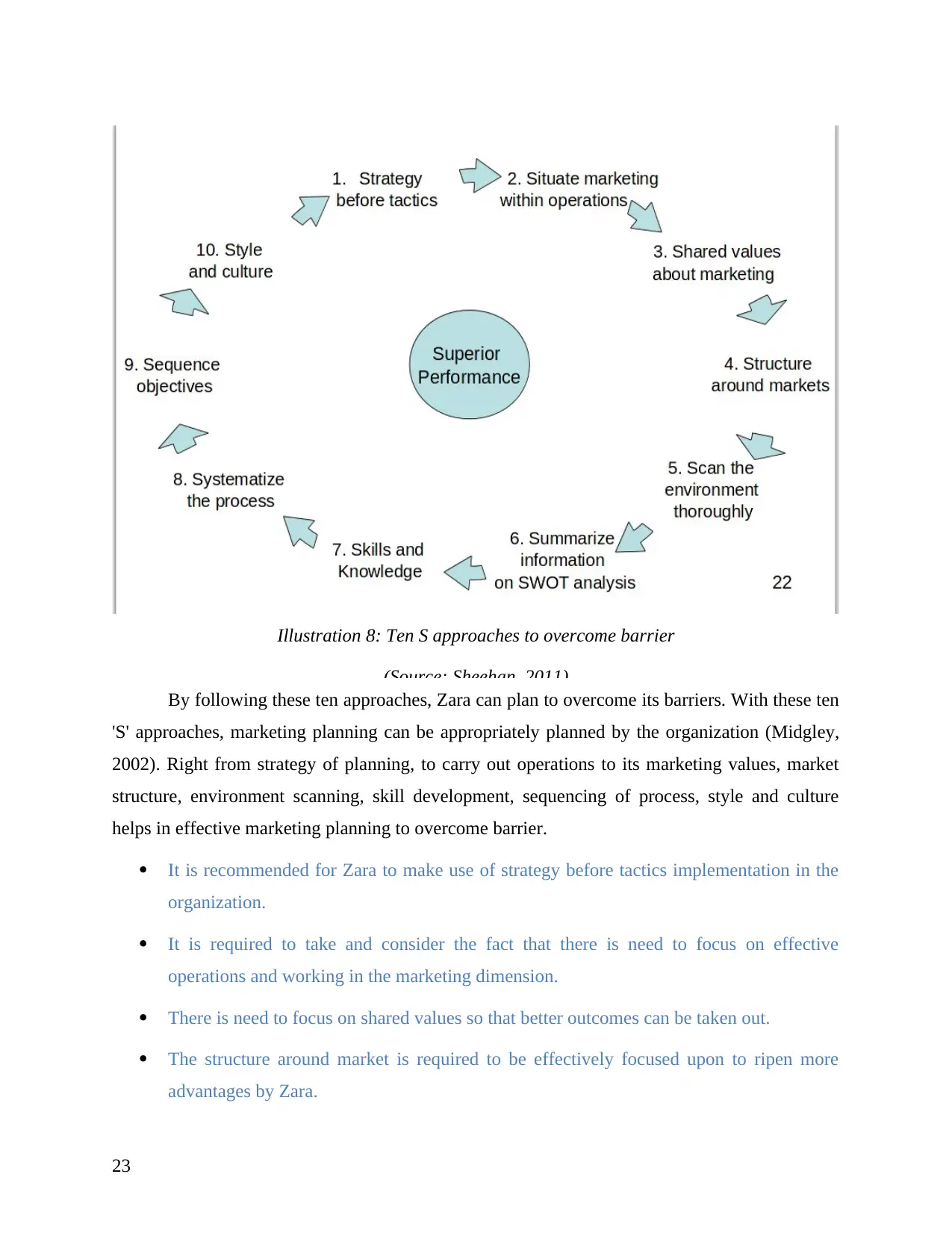
By following these ten approaches, Zara can plan to overcome its barriers. With these ten
'S' approaches, marketing planning can be appropriately planned by the organization (Midgley,
2002). Right from strategy of planning, to carry out operations to its marketing values, market
structure, environment scanning, skill development, sequencing of process, style and culture
helps in effective marketing planning to overcome barrier.
It is recommended for Zara to make use of strategy before tactics implementation in the
organization.
It is required to take and consider the fact that there is need to focus on effective
operations and working in the marketing dimension.
There is need to focus on shared values so that better outcomes can be taken out.
The structure around market is required to be effectively focused upon to ripen more
advantages by Zara.
23
Illustration 8: Ten S approaches to overcome barrier
(Source: Sheehan, 2011)
'S' approaches, marketing planning can be appropriately planned by the organization (Midgley,
2002). Right from strategy of planning, to carry out operations to its marketing values, market
structure, environment scanning, skill development, sequencing of process, style and culture
helps in effective marketing planning to overcome barrier.
It is recommended for Zara to make use of strategy before tactics implementation in the
organization.
It is required to take and consider the fact that there is need to focus on effective
operations and working in the marketing dimension.
There is need to focus on shared values so that better outcomes can be taken out.
The structure around market is required to be effectively focused upon to ripen more
advantages by Zara.
23
Illustration 8: Ten S approaches to overcome barrier
(Source: Sheehan, 2011)
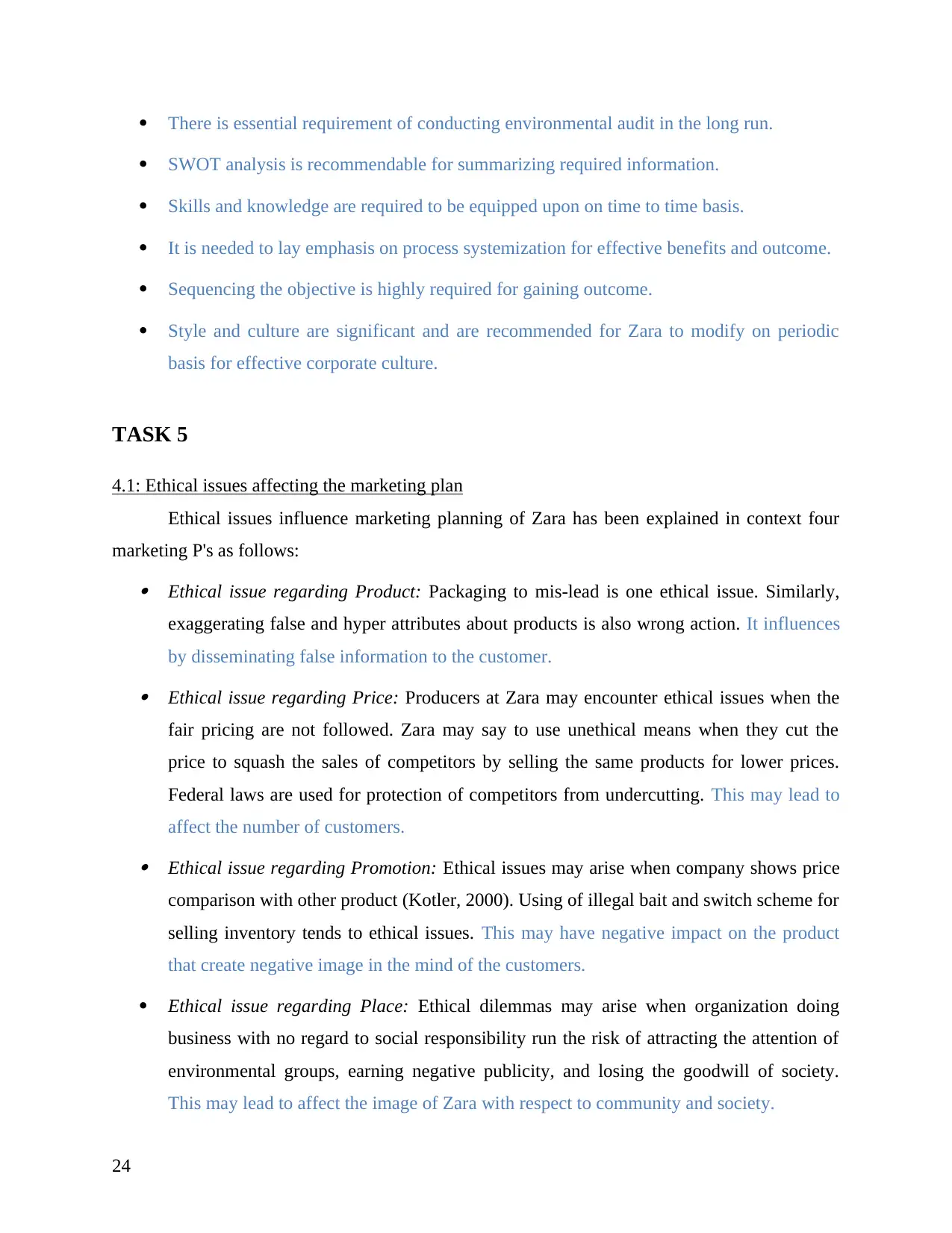
There is essential requirement of conducting environmental audit in the long run.
SWOT analysis is recommendable for summarizing required information.
Skills and knowledge are required to be equipped upon on time to time basis.
It is needed to lay emphasis on process systemization for effective benefits and outcome.
Sequencing the objective is highly required for gaining outcome.
Style and culture are significant and are recommended for Zara to modify on periodic
basis for effective corporate culture.
TASK 5
4.1: Ethical issues affecting the marketing plan
Ethical issues influence marketing planning of Zara has been explained in context four
marketing P's as follows: Ethical issue regarding Product: Packaging to mis-lead is one ethical issue. Similarly,
exaggerating false and hyper attributes about products is also wrong action. It influences
by disseminating false information to the customer. Ethical issue regarding Price: Producers at Zara may encounter ethical issues when the
fair pricing are not followed. Zara may say to use unethical means when they cut the
price to squash the sales of competitors by selling the same products for lower prices.
Federal laws are used for protection of competitors from undercutting. This may lead to
affect the number of customers. Ethical issue regarding Promotion: Ethical issues may arise when company shows price
comparison with other product (Kotler, 2000). Using of illegal bait and switch scheme for
selling inventory tends to ethical issues. This may have negative impact on the product
that create negative image in the mind of the customers.
Ethical issue regarding Place: Ethical dilemmas may arise when organization doing
business with no regard to social responsibility run the risk of attracting the attention of
environmental groups, earning negative publicity, and losing the goodwill of society.
This may lead to affect the image of Zara with respect to community and society.
24
SWOT analysis is recommendable for summarizing required information.
Skills and knowledge are required to be equipped upon on time to time basis.
It is needed to lay emphasis on process systemization for effective benefits and outcome.
Sequencing the objective is highly required for gaining outcome.
Style and culture are significant and are recommended for Zara to modify on periodic
basis for effective corporate culture.
TASK 5
4.1: Ethical issues affecting the marketing plan
Ethical issues influence marketing planning of Zara has been explained in context four
marketing P's as follows: Ethical issue regarding Product: Packaging to mis-lead is one ethical issue. Similarly,
exaggerating false and hyper attributes about products is also wrong action. It influences
by disseminating false information to the customer. Ethical issue regarding Price: Producers at Zara may encounter ethical issues when the
fair pricing are not followed. Zara may say to use unethical means when they cut the
price to squash the sales of competitors by selling the same products for lower prices.
Federal laws are used for protection of competitors from undercutting. This may lead to
affect the number of customers. Ethical issue regarding Promotion: Ethical issues may arise when company shows price
comparison with other product (Kotler, 2000). Using of illegal bait and switch scheme for
selling inventory tends to ethical issues. This may have negative impact on the product
that create negative image in the mind of the customers.
Ethical issue regarding Place: Ethical dilemmas may arise when organization doing
business with no regard to social responsibility run the risk of attracting the attention of
environmental groups, earning negative publicity, and losing the goodwill of society.
This may lead to affect the image of Zara with respect to community and society.
24
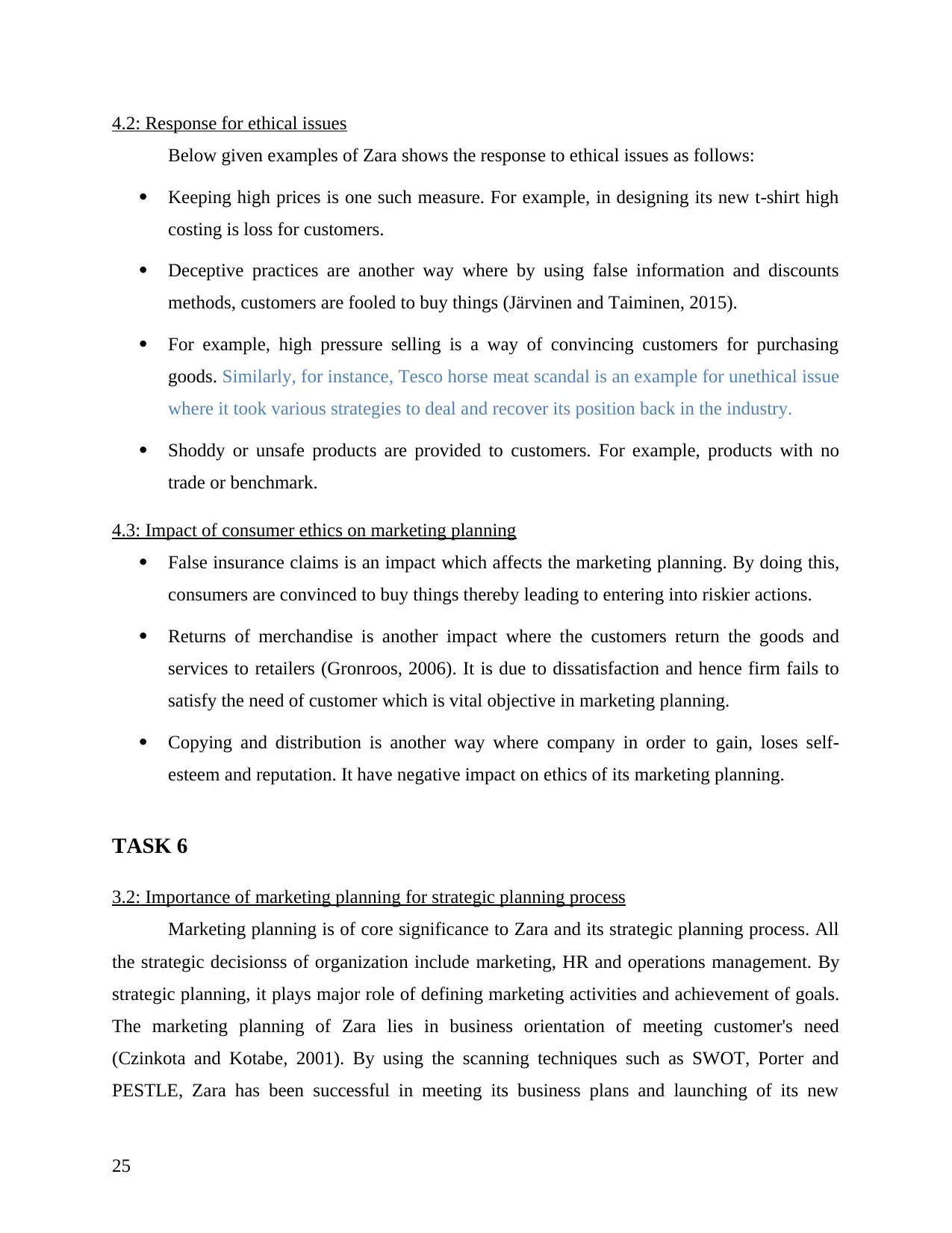
4.2: Response for ethical issues
Below given examples of Zara shows the response to ethical issues as follows:
Keeping high prices is one such measure. For example, in designing its new t-shirt high
costing is loss for customers.
Deceptive practices are another way where by using false information and discounts
methods, customers are fooled to buy things (Järvinen and Taiminen, 2015).
For example, high pressure selling is a way of convincing customers for purchasing
goods. Similarly, for instance, Tesco horse meat scandal is an example for unethical issue
where it took various strategies to deal and recover its position back in the industry.
Shoddy or unsafe products are provided to customers. For example, products with no
trade or benchmark.
4.3: Impact of consumer ethics on marketing planning
False insurance claims is an impact which affects the marketing planning. By doing this,
consumers are convinced to buy things thereby leading to entering into riskier actions.
Returns of merchandise is another impact where the customers return the goods and
services to retailers (Gronroos, 2006). It is due to dissatisfaction and hence firm fails to
satisfy the need of customer which is vital objective in marketing planning.
Copying and distribution is another way where company in order to gain, loses self-
esteem and reputation. It have negative impact on ethics of its marketing planning.
TASK 6
3.2: Importance of marketing planning for strategic planning process
Marketing planning is of core significance to Zara and its strategic planning process. All
the strategic decisionss of organization include marketing, HR and operations management. By
strategic planning, it plays major role of defining marketing activities and achievement of goals.
The marketing planning of Zara lies in business orientation of meeting customer's need
(Czinkota and Kotabe, 2001). By using the scanning techniques such as SWOT, Porter and
PESTLE, Zara has been successful in meeting its business plans and launching of its new
25
Below given examples of Zara shows the response to ethical issues as follows:
Keeping high prices is one such measure. For example, in designing its new t-shirt high
costing is loss for customers.
Deceptive practices are another way where by using false information and discounts
methods, customers are fooled to buy things (Järvinen and Taiminen, 2015).
For example, high pressure selling is a way of convincing customers for purchasing
goods. Similarly, for instance, Tesco horse meat scandal is an example for unethical issue
where it took various strategies to deal and recover its position back in the industry.
Shoddy or unsafe products are provided to customers. For example, products with no
trade or benchmark.
4.3: Impact of consumer ethics on marketing planning
False insurance claims is an impact which affects the marketing planning. By doing this,
consumers are convinced to buy things thereby leading to entering into riskier actions.
Returns of merchandise is another impact where the customers return the goods and
services to retailers (Gronroos, 2006). It is due to dissatisfaction and hence firm fails to
satisfy the need of customer which is vital objective in marketing planning.
Copying and distribution is another way where company in order to gain, loses self-
esteem and reputation. It have negative impact on ethics of its marketing planning.
TASK 6
3.2: Importance of marketing planning for strategic planning process
Marketing planning is of core significance to Zara and its strategic planning process. All
the strategic decisionss of organization include marketing, HR and operations management. By
strategic planning, it plays major role of defining marketing activities and achievement of goals.
The marketing planning of Zara lies in business orientation of meeting customer's need
(Czinkota and Kotabe, 2001). By using the scanning techniques such as SWOT, Porter and
PESTLE, Zara has been successful in meeting its business plans and launching of its new
25
Paraphrase This Document
Need a fresh take? Get an instant paraphrase of this document with our AI Paraphraser
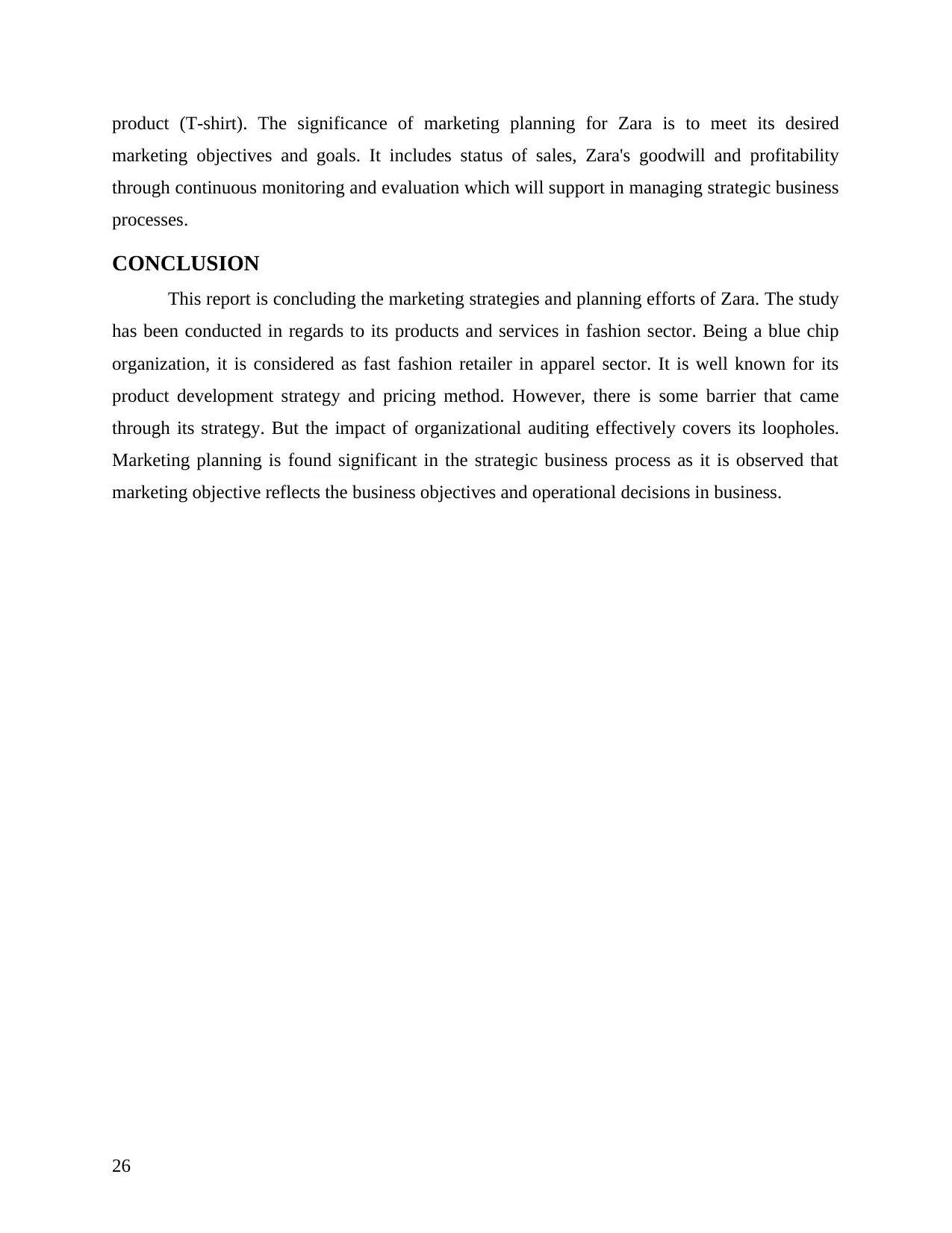
product (T-shirt). The significance of marketing planning for Zara is to meet its desired
marketing objectives and goals. It includes status of sales, Zara's goodwill and profitability
through continuous monitoring and evaluation which will support in managing strategic business
processes.
CONCLUSION
This report is concluding the marketing strategies and planning efforts of Zara. The study
has been conducted in regards to its products and services in fashion sector. Being a blue chip
organization, it is considered as fast fashion retailer in apparel sector. It is well known for its
product development strategy and pricing method. However, there is some barrier that came
through its strategy. But the impact of organizational auditing effectively covers its loopholes.
Marketing planning is found significant in the strategic business process as it is observed that
marketing objective reflects the business objectives and operational decisions in business.
26
marketing objectives and goals. It includes status of sales, Zara's goodwill and profitability
through continuous monitoring and evaluation which will support in managing strategic business
processes.
CONCLUSION
This report is concluding the marketing strategies and planning efforts of Zara. The study
has been conducted in regards to its products and services in fashion sector. Being a blue chip
organization, it is considered as fast fashion retailer in apparel sector. It is well known for its
product development strategy and pricing method. However, there is some barrier that came
through its strategy. But the impact of organizational auditing effectively covers its loopholes.
Marketing planning is found significant in the strategic business process as it is observed that
marketing objective reflects the business objectives and operational decisions in business.
26
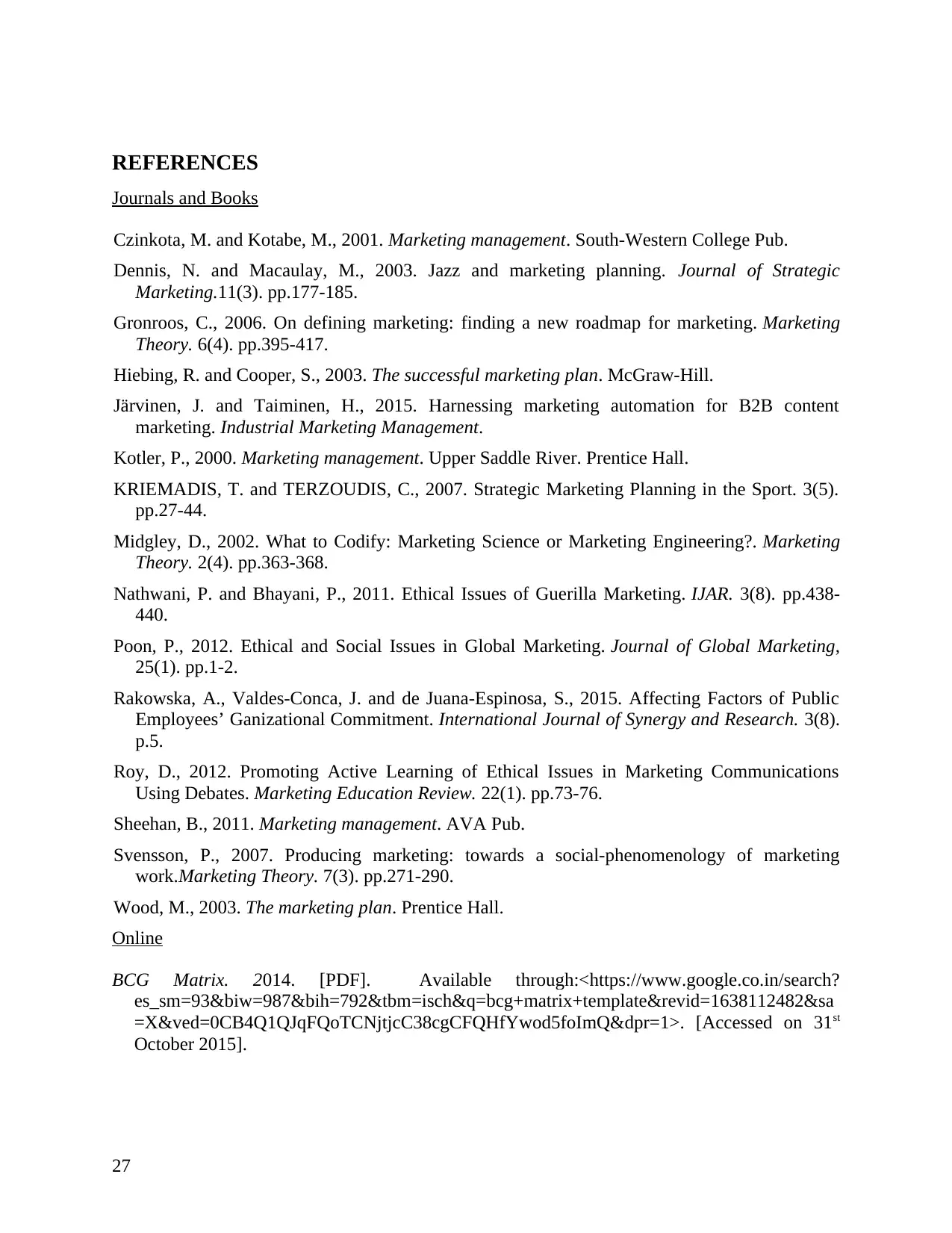
REFERENCES
Journals and Books
Czinkota, M. and Kotabe, M., 2001. Marketing management. South-Western College Pub.
Dennis, N. and Macaulay, M., 2003. Jazz and marketing planning. Journal of Strategic
Marketing.11(3). pp.177-185.
Gronroos, C., 2006. On defining marketing: finding a new roadmap for marketing. Marketing
Theory. 6(4). pp.395-417.
Hiebing, R. and Cooper, S., 2003. The successful marketing plan. McGraw-Hill.
Järvinen, J. and Taiminen, H., 2015. Harnessing marketing automation for B2B content
marketing. Industrial Marketing Management.
Kotler, P., 2000. Marketing management. Upper Saddle River. Prentice Hall.
KRIEMADIS, T. and TERZOUDIS, C., 2007. Strategic Marketing Planning in the Sport. 3(5).
pp.27-44.
Midgley, D., 2002. What to Codify: Marketing Science or Marketing Engineering?. Marketing
Theory. 2(4). pp.363-368.
Nathwani, P. and Bhayani, P., 2011. Ethical Issues of Guerilla Marketing. IJAR. 3(8). pp.438-
440.
Poon, P., 2012. Ethical and Social Issues in Global Marketing. Journal of Global Marketing,
25(1). pp.1-2.
Rakowska, A., Valdes-Conca, J. and de Juana-Espinosa, S., 2015. Affecting Factors of Public
Employees’ Ganizational Commitment. International Journal of Synergy and Research. 3(8).
p.5.
Roy, D., 2012. Promoting Active Learning of Ethical Issues in Marketing Communications
Using Debates. Marketing Education Review. 22(1). pp.73-76.
Sheehan, B., 2011. Marketing management. AVA Pub.
Svensson, P., 2007. Producing marketing: towards a social-phenomenology of marketing
work.Marketing Theory. 7(3). pp.271-290.
Wood, M., 2003. The marketing plan. Prentice Hall.
Online
BCG Matrix. 2014. [PDF]. Available through:<https://www.google.co.in/search?
es_sm=93&biw=987&bih=792&tbm=isch&q=bcg+matrix+template&revid=1638112482&sa
=X&ved=0CB4Q1QJqFQoTCNjtjcC38cgCFQHfYwod5foImQ&dpr=1>. [Accessed on 31st
October 2015].
27
Journals and Books
Czinkota, M. and Kotabe, M., 2001. Marketing management. South-Western College Pub.
Dennis, N. and Macaulay, M., 2003. Jazz and marketing planning. Journal of Strategic
Marketing.11(3). pp.177-185.
Gronroos, C., 2006. On defining marketing: finding a new roadmap for marketing. Marketing
Theory. 6(4). pp.395-417.
Hiebing, R. and Cooper, S., 2003. The successful marketing plan. McGraw-Hill.
Järvinen, J. and Taiminen, H., 2015. Harnessing marketing automation for B2B content
marketing. Industrial Marketing Management.
Kotler, P., 2000. Marketing management. Upper Saddle River. Prentice Hall.
KRIEMADIS, T. and TERZOUDIS, C., 2007. Strategic Marketing Planning in the Sport. 3(5).
pp.27-44.
Midgley, D., 2002. What to Codify: Marketing Science or Marketing Engineering?. Marketing
Theory. 2(4). pp.363-368.
Nathwani, P. and Bhayani, P., 2011. Ethical Issues of Guerilla Marketing. IJAR. 3(8). pp.438-
440.
Poon, P., 2012. Ethical and Social Issues in Global Marketing. Journal of Global Marketing,
25(1). pp.1-2.
Rakowska, A., Valdes-Conca, J. and de Juana-Espinosa, S., 2015. Affecting Factors of Public
Employees’ Ganizational Commitment. International Journal of Synergy and Research. 3(8).
p.5.
Roy, D., 2012. Promoting Active Learning of Ethical Issues in Marketing Communications
Using Debates. Marketing Education Review. 22(1). pp.73-76.
Sheehan, B., 2011. Marketing management. AVA Pub.
Svensson, P., 2007. Producing marketing: towards a social-phenomenology of marketing
work.Marketing Theory. 7(3). pp.271-290.
Wood, M., 2003. The marketing plan. Prentice Hall.
Online
BCG Matrix. 2014. [PDF]. Available through:<https://www.google.co.in/search?
es_sm=93&biw=987&bih=792&tbm=isch&q=bcg+matrix+template&revid=1638112482&sa
=X&ved=0CB4Q1QJqFQoTCNjtjcC38cgCFQHfYwod5foImQ&dpr=1>. [Accessed on 31st
October 2015].
27
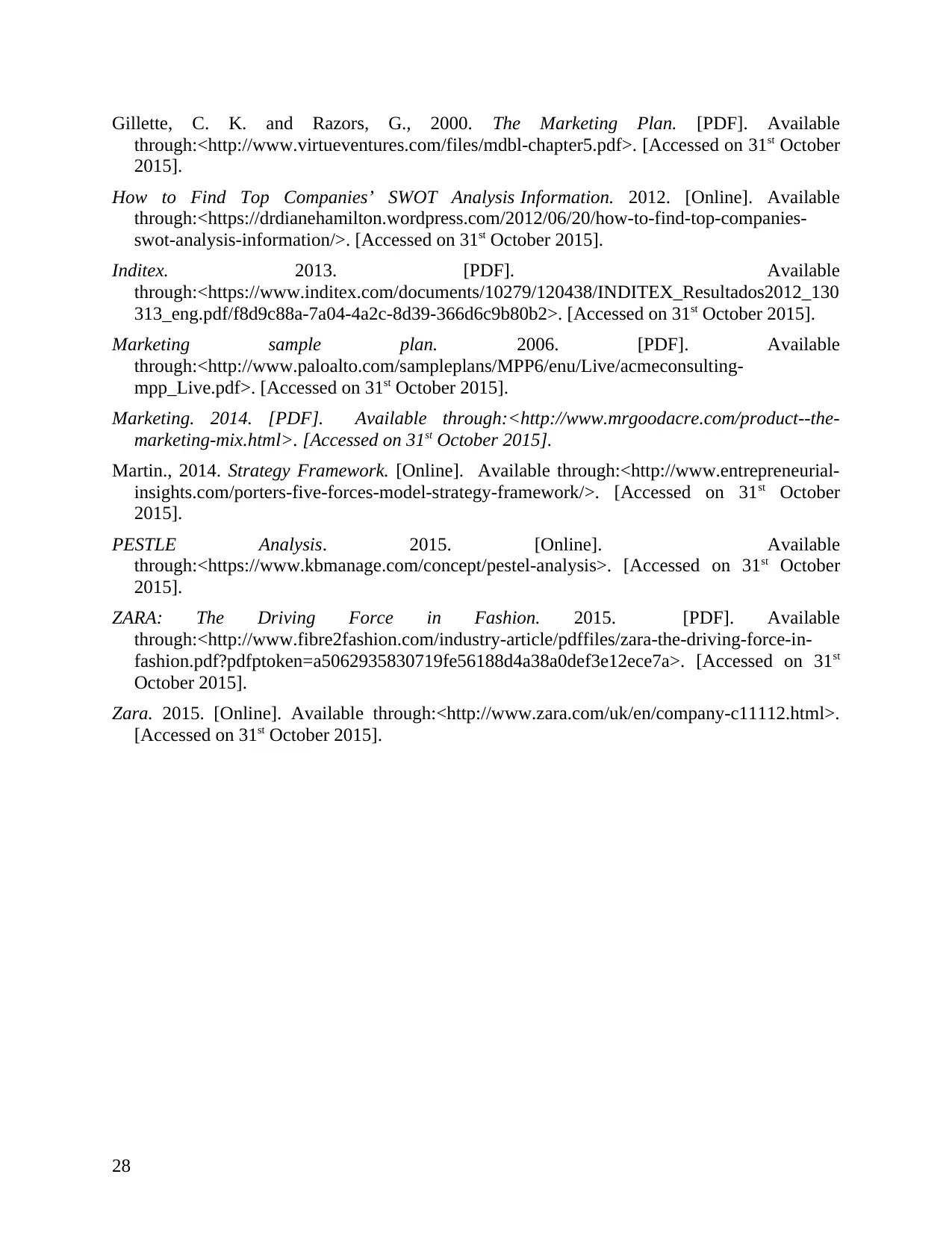
Gillette, C. K. and Razors, G., 2000. The Marketing Plan. [PDF]. Available
through:<http://www.virtueventures.com/files/mdbl-chapter5.pdf>. [Accessed on 31st October
2015].
How to Find Top Companies’ SWOT Analysis Information. 2012. [Online]. Available
through:<https://drdianehamilton.wordpress.com/2012/06/20/how-to-find-top-companies-
swot-analysis-information/>. [Accessed on 31st October 2015].
Inditex. 2013. [PDF]. Available
through:<https://www.inditex.com/documents/10279/120438/INDITEX_Resultados2012_130
313_eng.pdf/f8d9c88a-7a04-4a2c-8d39-366d6c9b80b2>. [Accessed on 31st October 2015].
Marketing sample plan. 2006. [PDF]. Available
through:<http://www.paloalto.com/sampleplans/MPP6/enu/Live/acmeconsulting-
mpp_Live.pdf>. [Accessed on 31st October 2015].
Marketing. 2014. [PDF]. Available through:<http://www.mrgoodacre.com/product--the-
marketing-mix.html>. [Accessed on 31st October 2015].
Martin., 2014. Strategy Framework. [Online]. Available through:<http://www.entrepreneurial-
insights.com/porters-five-forces-model-strategy-framework/>. [Accessed on 31st October
2015].
PESTLE Analysis. 2015. [Online]. Available
through:<https://www.kbmanage.com/concept/pestel-analysis>. [Accessed on 31st October
2015].
ZARA: The Driving Force in Fashion. 2015. [PDF]. Available
through:<http://www.fibre2fashion.com/industry-article/pdffiles/zara-the-driving-force-in-
fashion.pdf?pdfptoken=a5062935830719fe56188d4a38a0def3e12ece7a>. [Accessed on 31st
October 2015].
Zara. 2015. [Online]. Available through:<http://www.zara.com/uk/en/company-c11112.html>.
[Accessed on 31st October 2015].
28
through:<http://www.virtueventures.com/files/mdbl-chapter5.pdf>. [Accessed on 31st October
2015].
How to Find Top Companies’ SWOT Analysis Information. 2012. [Online]. Available
through:<https://drdianehamilton.wordpress.com/2012/06/20/how-to-find-top-companies-
swot-analysis-information/>. [Accessed on 31st October 2015].
Inditex. 2013. [PDF]. Available
through:<https://www.inditex.com/documents/10279/120438/INDITEX_Resultados2012_130
313_eng.pdf/f8d9c88a-7a04-4a2c-8d39-366d6c9b80b2>. [Accessed on 31st October 2015].
Marketing sample plan. 2006. [PDF]. Available
through:<http://www.paloalto.com/sampleplans/MPP6/enu/Live/acmeconsulting-
mpp_Live.pdf>. [Accessed on 31st October 2015].
Marketing. 2014. [PDF]. Available through:<http://www.mrgoodacre.com/product--the-
marketing-mix.html>. [Accessed on 31st October 2015].
Martin., 2014. Strategy Framework. [Online]. Available through:<http://www.entrepreneurial-
insights.com/porters-five-forces-model-strategy-framework/>. [Accessed on 31st October
2015].
PESTLE Analysis. 2015. [Online]. Available
through:<https://www.kbmanage.com/concept/pestel-analysis>. [Accessed on 31st October
2015].
ZARA: The Driving Force in Fashion. 2015. [PDF]. Available
through:<http://www.fibre2fashion.com/industry-article/pdffiles/zara-the-driving-force-in-
fashion.pdf?pdfptoken=a5062935830719fe56188d4a38a0def3e12ece7a>. [Accessed on 31st
October 2015].
Zara. 2015. [Online]. Available through:<http://www.zara.com/uk/en/company-c11112.html>.
[Accessed on 31st October 2015].
28
1 out of 28
Related Documents
Your All-in-One AI-Powered Toolkit for Academic Success.
+13062052269
info@desklib.com
Available 24*7 on WhatsApp / Email
![[object Object]](/_next/static/media/star-bottom.7253800d.svg)
Unlock your academic potential
© 2024 | Zucol Services PVT LTD | All rights reserved.





